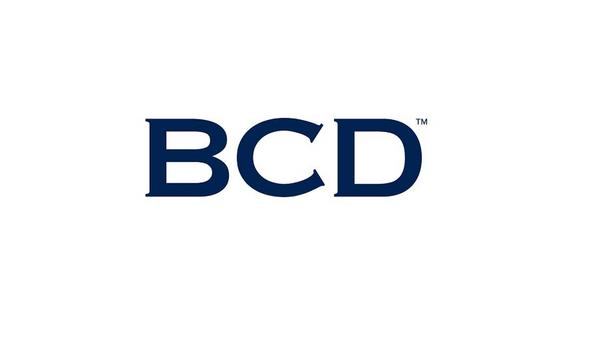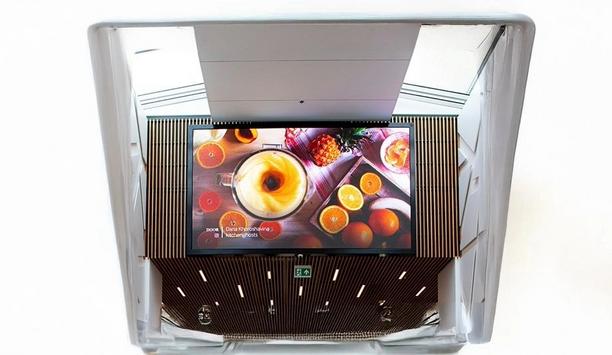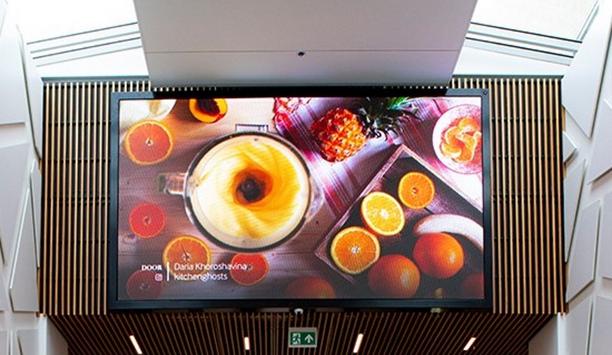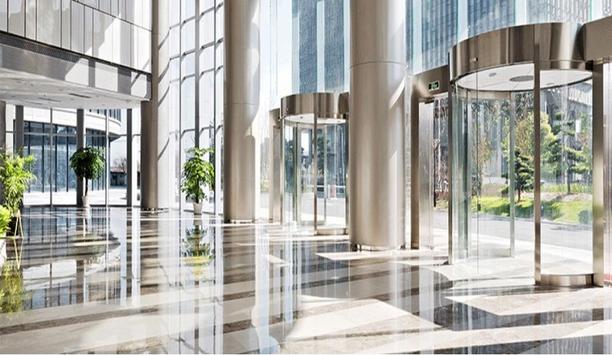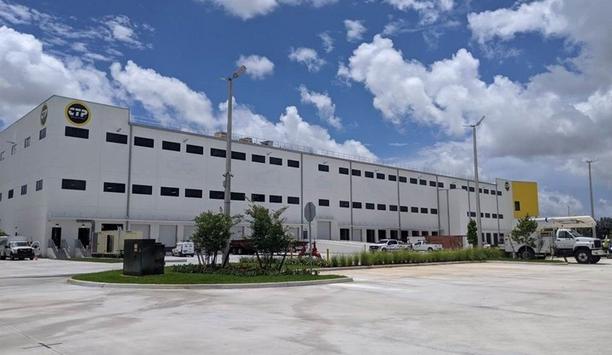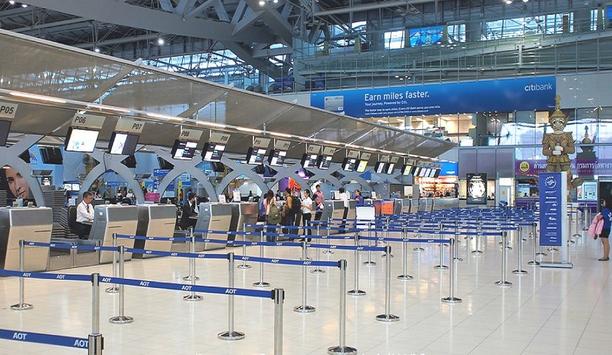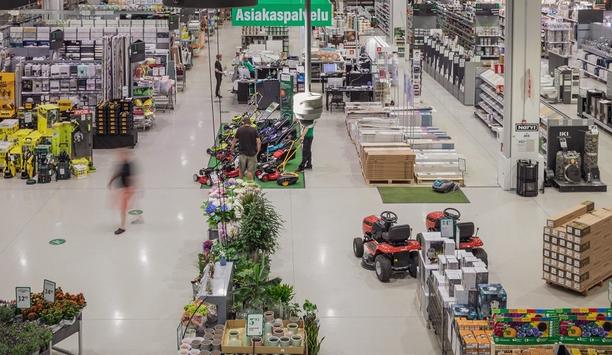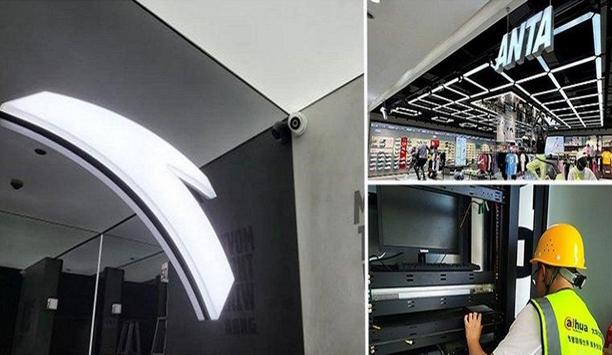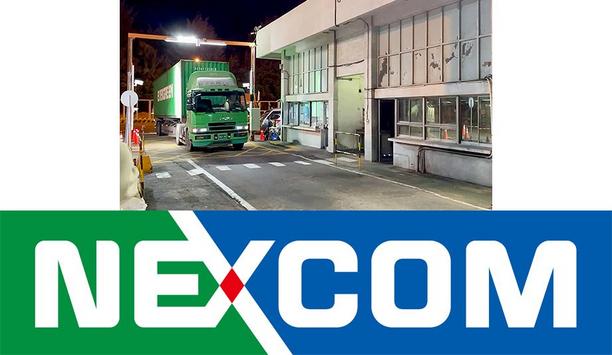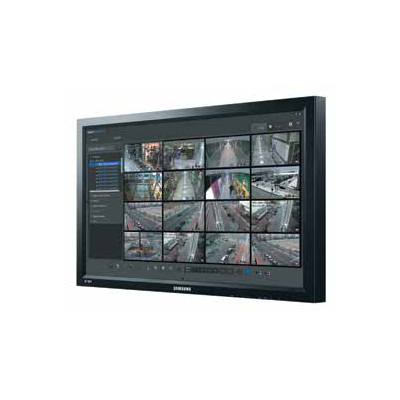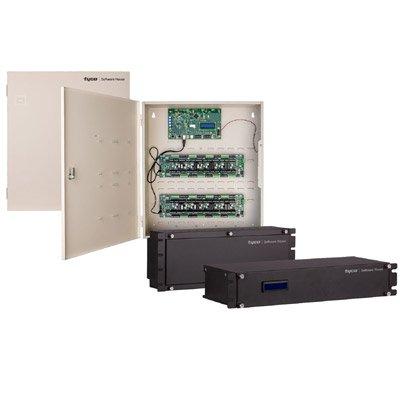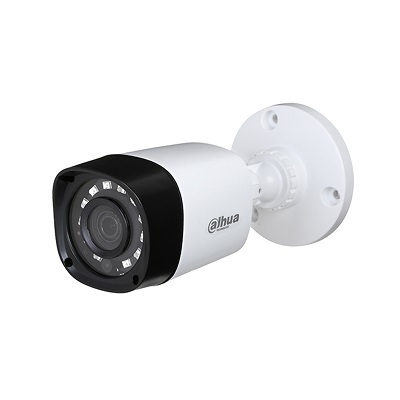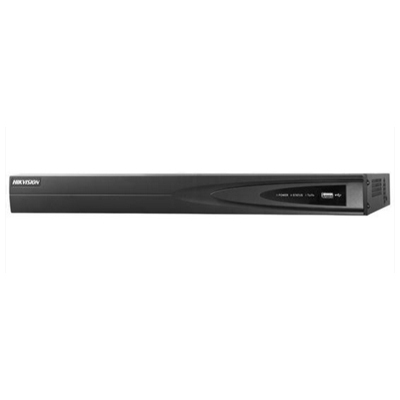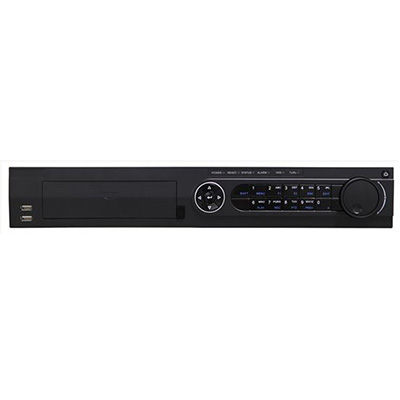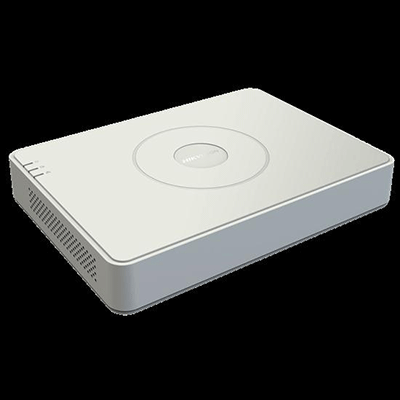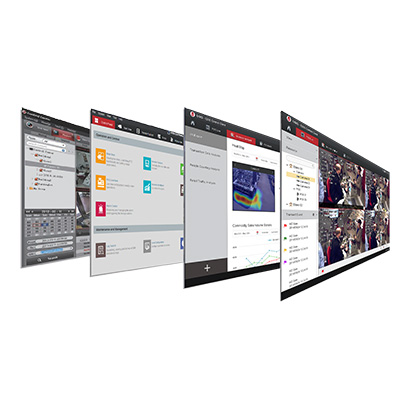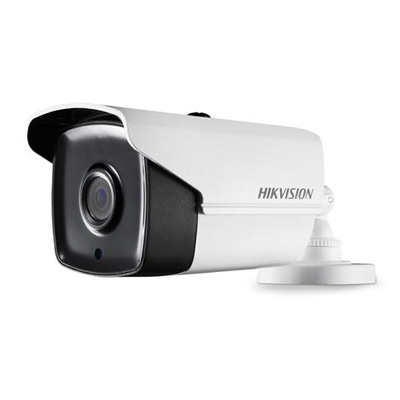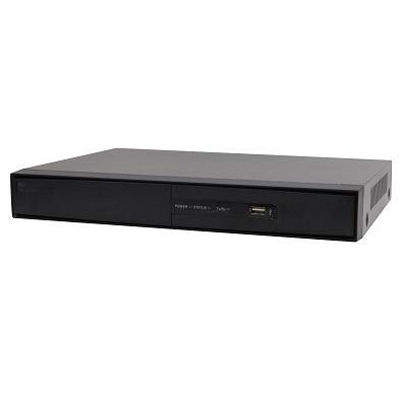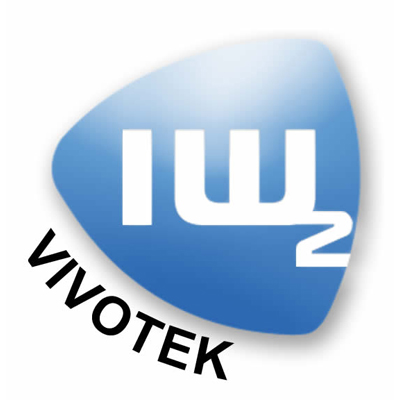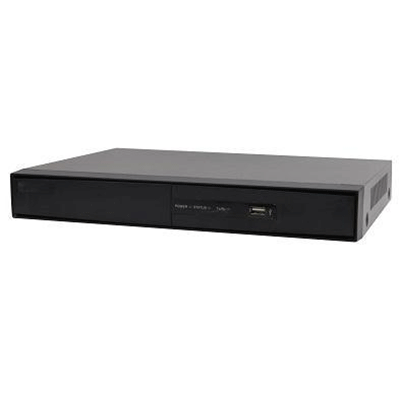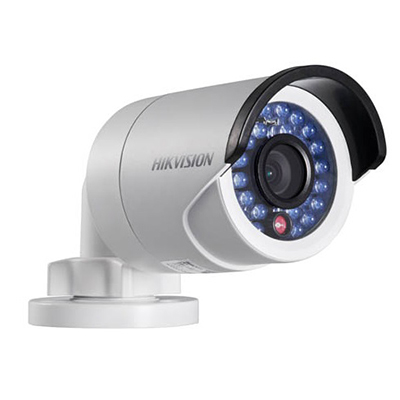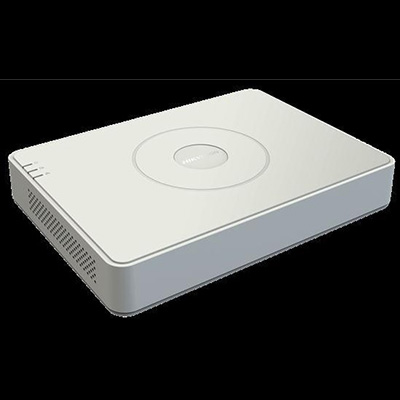Retail security applications
Upgrade the surveillance capabilities at MOD Pizza locations while maintaining a safe and welcoming “people-first” environment. Solution Install Hanwha Vision Q series and X series cameras (dome and fisheye models). Results Enhanced ability to deter and resolve in-store incidents involving customers and Squad members, as well as “slip and fall” accidents or crashes in the parking lot. Faster response times to police requests for surveillance footage. Hanwha secu...
Like any retail franchise, car dealerships that have multiple locations nationwide require comprehensive, reliable, and scalable video surveillance solutions to protect their businesses. With dealership theft increasing by 7% since 2021, protecting high-value inventory, mitigating liability risks, and ensuring compliance with video data retention standards have become critical priorities. Future surveillance solutions BCD is vital to guarding functions, protecting valuable assets, and maintai...
About a year and a half ago, Peter de Jong introduced Dahua to Fred Koks, General Manager of KITT Engineering. Since then, Dahua, KITT Engineering, and Ocean Outdoor have completed five joint projects. Follow-up appointments for the next two projects are already scheduled. Looking back "Let's see what happens" was Fred's reaction when introduced to Dahua. ''We evaluate our portfolio with suppliers every year,'' he explained. "We have to. So much is changing and new technology...
The building, constructed in 2005, consists of three 12-story towers with a total of 309 residential units. Residents have been experiencing issues with noise and unclear sound, which hinder effective communication and lead to frustration. Additionally, there is an increased need for remote unlocking capabilities. The existing 2-wire system, which supports only basic intercom functions, fails to meet the current needs of the residents. Solution highlights Easy Intercom Retrofitting with Ex...
The Ampelmännchen (“little traffic light man”) from the former GDR is a cult figure around the globe. For tourists, the shops of AMPELMANN GmbH in Berlin are a big draw. Branches are spread over the entire city, and to reduce the burden of employee and staff key assignments, the company sought to optimise access rights management. At the same time, branch security needed to be state-of-the-art. The CLIQ® access control solution from ASSA ABLOY met all these requirement...
About a year and a half ago, Peter de Jong introduced Dahua to Fred Koks, General Manager of KITT Engineering. Since then, Dahua, KITT Engineering and Ocean Outdoor have completed five joint projects together. Follow-up appointments for the next two projects are already scheduled. "Let's see what happens," was Fred's reaction when introduced to Dahua. ''We evaluate our portfolio with suppliers every year,'' he explained. “We have to. So much is changing and new technology is develo...
News
NViS 1482, NEXCOM’s newest desktop NVR, promises big things in a small package. Integrating Intel’s latest, top-of-the-line 8th Gen (Elkhart Lake) CPU and 11th Gen UHD GPU, the entry-level NVR appliance is the perfect companion to IP cameras for recording high-definition digital surveillance. Using Intel’s latest technology means it supports a whopping 32GB DDR4 3200 MHz memory so that jobs are much faster. Easily plug in up to eight IP cameras via 10/100 IEEE802.3af/at PoE ports, quickly upload data to the edge or cloud through the onboard Intel® 2.5GbE port, and effortlessly view information via HDMI or DVI-I displays. The latest and greatest NViS supports expanded 32GB DDR 3200 MHz memory, meaning that any data workload will be a breeze Outstanding processing and graphics performance, on top of high-speed Ethernet connections, are brought to you by Intel’s newest solutions. The backbone of the compactly-sized desktop NVR is the solid, quad-core 8th Gen Elkhart Lake CPU. With its remarkable multithread performance, it even supports expanded 32GB DDR 3200 MHz memory, meaning that any data workload will be a breeze. The CPU also pairs beautifully with the newest 11th Gen Intel® UHD integrated graphics controller for more stunning and detailed displays. But NEXCOM would be amiss if it neglected to point out the Intel® 2.5GbE port (and additional 1GE port) for speedy data transmissions. Captivating camera captures Digital surveillance NVR devices would be useless without their cameras, which is why the NViS 1482 supports eight 10/100 802.3af PoE ports (or four 802.3at). It can easily capture clear, high-definition images, as it’s compatible with a wide range of megapixel IP cameras, and capable of recording 4K resolutions and 2M frame rates with a 9ch camera per channel running at 30FPS, performance-wise it is benchmarked by Milestone XProtect software. NEXCOM also provides LED lights to easily monitor PoE activities for users to easily recognize device status on the front. Moreover, one 3.5” HDD SATA drive with support up to 18TB capacity can store your mass data. The NViS 1482, combining effortlessly with third-party VMS software, is, therefore, the perfect choice for retail environments, small businesses, and SOHO. Easy-breezy, safe and shielded NVR appliance is designed for easy implementation and incorporates critical safety and security mechanisms The NVR appliance is specifically designed for easy implementation and incorporates critical safety and security mechanisms. A wide variety of I/Os includes six USB ports and support for dual displays: HDMI 2.0 (up to 4k resolution) and DVI. Though it’s a standard 1U desktop appliance, it also emphasises versatility with optional mounting: a choice between rackmount or wall mount brackets. The embedded TPM 2.0 ensures data security, while full UL 62368 compliance guarantees that the NViS 1482 meets hazard-based electrical safety standards. Main features Supports 8th Gen Intel Atom® processor X series and Celeron® J series 1 x SATA supports 2.5” HDD/SSD (M.2 as either one option) 1 x SATA supports 3.5” HDD Multiple displays (HDMI+DVI-I) 1 x 1GbE Intel®Ethernet + 1 x 2.5GbE Ethernet Supports 8-port PoE switch (PSE up to 120W)
Scenario: One needs to install a camera in the lobby of a building to capture the entrance area. Problem: The area has a lot of windows which overexposes the image, making it difficult to capture the people coming in and out of the premises. Solution: A security camera with a good Wide Dynamic Range (WDR). What WDR does? Dynamic range refers to the ratio between the largest and smallest measurable quantities of something. In the case of video surveillance, the dynamic range measures the ratio between the lightest and darkest elements of the image. WDR technology is great for high contrast scenes, balancing the brightness and shaded areas simultaneously so an image neither appears blown out or too dark. IHS defines WDR at 60 dB or greater, though it’s not uncommon to see WDR cameras with capabilities of 120 dB or more Decibels (dB) are the value with which dynamic range is measured. IHS defines WDR at 60 dB or greater, though it’s not uncommon to see WDR cameras with capabilities of 120 dB or more. However, keep in mind that each manufacturer has its own method of determining a camera’s dB. Therefore, when comparing product datasheets, it is possible that a camera with a lower ratio outperforms a competitor with a higher dB ratio. How WDR works? Security cameras with WDR technology (e.g. Dahua HDCVI 6.0 PLUS) are using either Digital WDR (DWDR) or True WDR. True WDR uses image sensors and a Digital Signal Processor (DSP) to provide even illumination to all areas of an image. A True WDR-enabled video surveillance camera has sensors that take two scans of each video frame. The first, at low speed (to capture more light), shows the image in normal light conditions. The second scan is taken at high speed to capture less light overall and get an image with strong light in the background. The DSP combines the two scans to form a single, balanced, well-illuminated image. DWDR uses algorithms instead of sensors to digitally brighten too-dark areas and dim too-bright areas. DWDR relies on the DSP chip instead of the image sensor to provide WDR. It adjusts each individual pixel of the image and calculates exposure accordingly. This technique has some limitations: the intense manipulation of pixels leads to the overall image being grainier. On the other hand, DWDR doesn’t need costly image sensors, so DWDR can be a more economical option when WDR is a necessity. When one doesn’t have WDR? Backlight Compensation (BLC) brightens the image so one can see darker details better There are two options for improving the exposure of an image without using WDR. In a high-contrast scene with heavy, broad, backlighting, the camera will adjust to the average illumination, which will darken the image. If no WDR is available, Backlight Compensation (BLC) brightens the image so one can see darker details better. BLC is a legacy technique that uses DSPs to increase the level of exposure for the entire image. Rather than balancing brightness on overexposed and underexposed areas of an image like WDR does, it brightens the entire image. Highlight Compensation (HLC) is a technology where image sensors detect strong light within the image and reduce exposure on those areas to enhance the overall image quality. In a dimly lit scene with bright lighting caused by hot spots (e.g. headlights, street lights), the overall image may become too dark. If no WDR is available, use HLC. The camera automatically suppresses bright light sources, allowing proper exposure of adjacent areas. Conclusion Regardless of the dB value specified, image results will vary depending on the complexity and amount of movement in a scene. To determine the best camera for an application, it is always best to test that it meets the needs and expectations of the customer.
A time attendance system can help to keep a close eye on an employee’s working hours, prevent time theft by accurately tracking and recording employees’ time and attendance. A biometric time attendance system allows employees to clock in quickly and easier compare to the standard system and eliminate “buddy punching” in advance to the traditional time card system. A complete biometric time attendance system includes both hardware and software. Include the electronic divide that scans an employee’s fingerprint or iris and software that stores all the data about time and shifts. Hardware and software can be purchased separately, but it’s best to find a vendor that provides both of them as a complete package. Price of the biometric software Small companies can purchase a basic system that includes hardware and software for about $1,000 to $1,500 Biometric time and attendance systems aren’t as expensive as one might think. Small companies can purchase a basic system that includes hardware and software for about $1,000 to $1,500. Some companies' solution, which works for companies with up to 50 employees, retails for $995 to $1,300. The price includes one fingerprint scanner and software that tracks arrivals and departures, calculates hours for payroll, and tracks vacation time and sick days. Large corporations with many hundreds or thousands of employees should expect to spend at least $10,000 on a biometric time and attendance system. For a complex system serving thousands of employees and multiple locations, the cost could rise as high as $100,000. In addition to a basic software and hardware package, one may need to purchase additional features, services, or accessories. Additional biometric scanners begin at about $1,000 to $1,300 each. Training begins at about $300 to $500 for smaller businesses and can run thousands for larger companies. Accessories like scanner covers, which protect the equipment when it is not in use, begin at about $30 to $50 each. CrossChex Cloud CrossChex Cloud's features include face recognition attendance, temperature, and mask identification Because there are so many options, it helps to talk to vendors about the products they provide. Some will charge an upfront fee for a set number of traditional software licenses; others will charge a monthly fee for web-hosted software. Although the market and advanced technology decrease the price of time and attendance system, some small companies or workshops still can’t afford extra spend besides salaries. Anviz introduces a new solution for those business owners - CrossChex Cloud. One can set up a new account and get only one hardware connected to be a lifetime free subscriber of CrossChex Cloud. Start at $500 only, one can get hardware that is suitable for CrossChex Cloud with advanced features includes: face recognition attendance, temperature, and mask identification, and get records of almost everything one wants to take control of.
Sweden-based AP&T supplies production solutions to manufacturers worldwide, including automation, presses, furnace systems, and tooling, for the manufacturing of press-hardened vehicle parts for the automotive industry. Car manufacturers are using lighter sheet materials, such as aluminium and thinner steel, to form robust parts for car body frames. When pressed, these lighter materials still produce a strong body frame meeting required safety standards without adding unnecessary weight to a car’s build which can drain both fuel and battery life. Measure and monitor sheet materials AP&T needed a solution to measure and monitor sheet materials before and after pressing. It is necessary to guarantee even heat distribution from the furnace before the sheets are pressed, the exact placement of the sheets, and to ensure that there are no hot spots after the sheets were cooled in the press tool. If any of these three conditions is not met, the required mechanical properties of the safety-relevant components will not be reached. This causes rejected parts, wasted materials, and additional manufacturing time. Also, the press tool itself might be damaged. The IPHA System - Thermal imaging for non-contact temperature monitoring To save car manufacturers time and money by preventing defect-pressed parts, AP&T reached out to Swedish thermal imaging integrator Termisk. Termisk designed an Infrared Press Hardening Analysis (IPHA) vision system that can measure the three main factors affecting sheet pressing quality: temperature before and after pressing, and sheet placement in the press. Using Teledyne FLIR thermal imaging cameras mounted to the sides of press machines, the IPHA system measures the temperature of metal sheets using the Teledyne FLIR A70 smart sensor camera (previously A315) or Teledyne FLIR A615 camera depending on the required image quality. Accurately measuring heat distribution on shaped metal sheets The IPHA system features a Teledyne FLIR thermal imaging camera on each side of the press with wide-angle lenses. The setup ensures the temperature is measured accurately for the whole surface area of the 3D-shaped sheet material. The process is automated, so once pieces are inside the press, the press-line controller system signals to IPHA to take an image and analyse it. Once the positioning and temperature are determined as ok, a signal is sent back to the press line to proceed. High-resolution thermal images Similarly, it then measures the sheet temperature and inspects heat distribution after pressing, after the shaped part is cooled. Unless there are any issues or alarms raised, there is minimal interference needed from an operator. The high-resolution thermal images make it quick and easy to identify hot spots and measure the areas where the material has not reached the correct temperatures. The system makes tool pressing and changeovers quick and simple too. The software allows manufacturers to pre-set temperature analysis parameters for the different pressing tools used. This allows the IPHA system to re-configure quickly during changeovers. Accurate and flexible thermal imaging solutions Teledyne FLIR’s A70 image streaming camera is ideal for advanced condition monitoring. In this case, the Teledyne FLIR A70 is capable of monitoring the temperature and heat distribution on steel sheets, even with raised parts, using non-contact temperature sensors. The wide-area monitoring capabilities of the A70 cameras mean that two cameras: one on each side of the press is enough to monitor the large steel sheets. The cameras will alert operators to any issues so they can investigate and rectify them immediately to prevent wasted materials and additional production time. Teledyne FLIR A615 camera For sites that require higher thermal imaging quality, the Teledyne FLIR A615 camera is a powerful alternative to the A70 in IPHA. Offering the same non-contact temperature measurement, the A615 provides higher accuracy and can detect temperature differences even at long distances. Termisk has implemented at least 40 IPHA systems for pressed part manufacturer AP&T worldwide. The thermal imaging solution can be installed on new lines or retrofitted to existing lines.
More than one million electric vehicles are registered in the U.S.—and they all have to plug in somewhere. As EV charging stations pop up across the country, one of the chief questions will be how charging station users are identified, authenticated, and connected with membership or payment systems. Radio-frequency identification cards and tokens and smartphone authentication apps have emerged as two viable options for EV charging authentication. Which is best? It may depend on the user base they plan to serve. User authentication for EV charging Most electric vehicle owners have a spot to plug in while at home, either in their own garage or carport or in a designated charging spot in a tenant parking garage. But electric vehicles also need spots to charge while owners are out and about. The EV charging market is broadly divided into two tiers: Level 2 charging stations, which operate at 208-240 V and use AC power. These stations will add 20-25 miles of range in about an hour of charging. The U.S. Department of Transportation listed more than 22,800 public Level 2 EV charging stations across the nation as of mid-2020. They are commonly found in public parking lots and garages, hotels, grocery stores, malls, and other commercial areas. They may also be installed in private parking garages and business parking lots for use by tenants, employees or fleet drivers. Collecting membership data Direct Current Fast Chargers (DCFS) are designed to charge an EV battery to about 80% in 20-30 minutes. There are currently about 15,000 DCFC stations across the U.S., but their numbers are expected to explode as more people start taking EVs on longer road trips. They are commonly found along major interstate highways. As the market evolves, user authentication requirements for EV charging stations are likely to vary by type, location, and user base. Some commercial locations may provide Level 2 EV charging as a free amenity to shoppers, guests or employees. If there is no charge for the service, there may be no need to authenticate users at all— people can simply park and plug at any available spot. However, there may be a benefit to collecting membership data (e.g., shopper reward club). Private charging stations Public, for-profit EV charging stations, like gas stations, need a method to collect payment for their services. In some cases (especially at roadside DCFS stations), users may simply pay for the minutes used with a credit card—just like at the gas station pump. However, many EV charging station users are already accustomed to identifying themselves with an RFID membership card or a smartphone app. Charging networks like ChargePoint and Blink enable members to access any EV charging station within their networks with a card or smartphone app, which connects to their membership, account, and payment information. Private charging stations—such as those offered to tenants, employees or fleet drivers—may not require payment but need to ensure that only authorised drivers are accessing power and taking up valuable parking spots. An RFID card or smartphone app can be used to identify authorised drivers and track charging behaviours. Moving forward, many EV charging stations may find that they need a mix of options for users, including membership cards, smartphone apps, and a credit card payment option for out-of-network drivers. Choosing between RFID and smartphone apps In the long run, the answer may be ‘both.’ RFID cards are economical and easy to issue When user identification and authentication are desirable, which is the better option: RFID cards or smartphone authentication? Both have their uses in the EV charging market. In the long run, the answer may be ‘both.’ RFID cards are economical and easy to issue. And for some users bases, they may not have to issue a new card at all—they can take advantage of an RFID card they already carry. In many cases, it is possible to leverage existing employee IDs and membership cards for access to privately controlled EV charging stations. RFID membership cards may be a good bet for: Fleet drivers who already carry an RFID card for vehicle access. Employee parking lots and garages where people already use a card for entry. EV charging parking spots at gyms or other locations where users want to limit charging access to active members. EV charging stations Most consumers would prefer not to have to carry a physical membership card for every retail outlet On the other hand, public charging stations may find that consumers would prefer to use a smartphone app rather than receive another membership card to carry in a physical wallet. Many consumers prefer to carry only their phone and one or two essential cards (such as a driver’s licence and a single credit or debit card). As more retailers enable consumers to pay via a digital wallet app on their smartphones, some don’t even carry a physical credit card anymore. Most consumers would prefer not to have to carry a physical membership card for every retail outlet they visit—and that includes EV charging stations. Smartphone apps for user authentication are simple to set up and highly secure. Instead of RFID, they typically use either Bluetooth® Low Energy (BLE) or Near-field Communication (NFC) protocols. Public charging stations For the user, the experience is almost identical to RFID authentication, except they wave a smartphone over the reader instead of a card. Apps have other user benefits, too. A custom app for EV charging can be configured to help users locate or reserve charging stations, check their balance and usage history, and change their payment options right on their phone. These features make smartphone authentication ideal for consumers These features make smartphone authentication ideal for consumers accessing a network of public charging stations. However, EV charging network managers should keep in mind that some users may still want a physical membership card. Smartphone-based authentication There are still some user populations, such as older consumers and those from lower income brackets, where smartphone ownership is not ubiquitous. If users are primarily using EV charging for a fleet vehicle, they may not want to download an application for work on their personal cell phone. Other users may find smartphone apps confusing or simply prefer to have a card for other reasons. The answer for both public EV charging networks and private charging station owners is to have an RFID reader that is capable of both card-based and smartphone-based authentication. This will provide maximum flexibility as user preferences change. Finding the right RFID reader for EV charging The ELATEC TWN4 MultiTech family of readers is ideal for authentication at EV charging stations The best RFID reader for EV charging is one that is flexible enough to meet the needs of all user populations and evolve as requirements change. The ELATEC TWN4 MultiTech family of readers is ideal for authentication at EV charging stations. The readers support 60+ RFID transponder technologies along with BLE and NFC smartphone authentication. This means that one reader can support all common technologies already in use across the entire user base—both nationally and internationally. This capability becomes important for applications where users want to enable drivers to use an existing RFID card (such as their employee or fleet ID card or an access card for a tenant parking garage) for access to charging locations. It also provides more flexibility as technologies or preferences change in the future. Supporting advanced encryption TWN4 MultiTech supports advanced encryption and security configurations for highly secure transactions between the card or smartphone and the reader. This is important for EV charging applications tied to payment or employee/driver identification. ELATEC readers are mobile-ready. The ELATEC Mobile Badge BLE NFC App offers simple and effective components for building or extending a mobile application for EV charging networks. Non-managed mobile credentialing using the ELATEC app is free. TWN4 MultiTech readers also work with multiple existing third-party managed credential systems, such as KleverKey, Safetrust, and Transact. The TWN4 MultiTech is easy to customise with the powerful Software Development Kit (DevPack) and App Blaster and Director utilities. Readers can be easily configured to support custom functionality (such as LED light flashing sequences or sounds for user feedback) and integration with backend software for easier member management. The DevPack tools make the TWN4 family the most powerful, versatile, and sustainable readers on the market. Hardware communication interfaces As electric vehicles move from niche to mainstream, EV charging infrastructure will need to grow and evolve to accommodate millions more drivers—both in the consumer market and in commercial fleets. With TWN4 MultiTech, EV charging station managers will be ready. Interested in learning more about technical considerations for RFID? Download 11 Considerations for Embedded System RFID Readers for additional advice, including operating power and consumption requirements, antenna placement, hardware communication interfaces, and more.
Bosch has equipped the new Chinese mega-airport Chengdu Tianfu International with video security, a PA and voice alarm system, and a conferencing solution, ensuring safety and security for passengers and airport staff as well as enhancing comfort and ease-of-use for travellers. Chengdu Tianfu International, in Sichuan province, serves China’s quickly booming ‘garden’ megacity, an emerging hub for commerce, culture, and finance – with the new airport pegged to be the third-busiest for airport traffic following Beijing and Shanghai. Customised audio and video The installation of the audio and video technology was customised for the unique architectural requirements of the airport complex, which opened this June, including two terminal buildings that reference the ancient Golden Sun Bird totem unearthed in 2001 from Chengdu City’s Jinsha Ruins. Due to the unique design of the terminal buildings, ‘standard’ security cameras were not appropriate for installation as the ceilings were far too high for traditional solutions. Placing regular cameras on this ceiling would drastically reduce the quality of their image feed and produce a poor viewing angle. Each panoramic camera can monitor a semi-circle area with a radius of 25 metres, a detection range of 25 metres in distance Flexidome panoramic cameras Instead, Bosch Flexidome panoramic cameras were integrated into the interior design of the building and were either installed on walls or concealed within information boards. Each panoramic camera can monitor a semi-circle area with a radius of 25 metres, a detection range of 25 metres in distance, and a 180-degree viewing angle. This allowed the airport to install far fewer cameras, cutting the total number down by 75% from 4,000 standard cameras for a typical project of this scale to 1,000 panoramic cameras – thus saving costs on the cameras as well as on wiring and installation. Uses single lens, 4K-resolution Dinion IP cameras Additionally, competitors’ panoramic cameras usually use four lenses, reducing the image quality. Bosch Flexidome cameras, however, use just one lens – improving brightness, colour, and clarity. The precision tracking capabilities and high-quality video stream of the cameras ultimately free up human resources for the airport and allow incidents or events to be followed without additional staff on the ground. In the flight area, the airport deployed four 4K-resolution Dinion IP cameras to monitor the runway. As this area of the airport is very long, stitching software is used to combine the images of these four cameras into one complete image, covering the entire runway and allowing Chengdu Tianfu to monitor the whole take-off and landing process. Seamless customer experience with superior acoustics The design team ran an acoustic simulation to ascertain how many loudspeakers were needed As the interiors of the terminal buildings feature many glass surfaces, which cause sound reflections, Chengdu Tianfu needed to determine how to deliver a high level of speech intelligibility with minimal distortion, no matter where the passengers were located. The design team ran acoustic simulation software to ascertain how many loudspeakers were needed for the terminal areas as well as the placement of the arrays. Bosch Praesideo system For flight announcements as well as voice alarm and evacuation more than 9,000 loudspeakers were installed, covering 700 broadcasting zones and integrated via a Bosch Praesideo system, assuring passengers can hear announcements in all parts of the terminal. Additionally, announcements can be broadcast with accuracy to passengers travelling through other areas of the airport complex, such as the adjoining hotel. Dicentis wireless conferencing system Bosch also provided the Dicentis Wireless Conferencing System for the adjoining supporting airport offices. Meanwhile, the Praesensa public address and voice alarm system deployed at the airport hotel is integrated with the rest of the site, so passengers staying at the hotel can be alerted to ongoing events in the airport. Due to these integrated sound and video systems, the airport can guarantee security and safety for passengers while also providing a seamless experience for customers and staff.
NViS 1482, NEXCOM’s newest desktop NVR, promises big things in a small package. Integrating Intel’s latest, top-of-the-line 8th Gen (Elkhart Lake) CPU and 11th Gen UHD GPU, the entry-level NVR appliance is the perfect companion to IP cameras for recording high-definition digital surveillance. Using Intel’s latest technology means it supports a whopping 32GB DDR4 3200 MHz memory so that jobs are much faster. Easily plug in up to eight IP cameras via 10/100 IEEE802.3af/at PoE ports, quickly upload data to the edge or cloud through the onboard Intel® 2.5GbE port, and effortlessly view information via HDMI or DVI-I displays. The latest and greatest NViS supports expanded 32GB DDR 3200 MHz memory, meaning that any data workload will be a breeze Outstanding processing and graphics performance, on top of high-speed Ethernet connections, are brought to you by Intel’s newest solutions. The backbone of the compactly-sized desktop NVR is the solid, quad-core 8th Gen Elkhart Lake CPU. With its remarkable multithread performance, it even supports expanded 32GB DDR 3200 MHz memory, meaning that any data workload will be a breeze. The CPU also pairs beautifully with the newest 11th Gen Intel® UHD integrated graphics controller for more stunning and detailed displays. But NEXCOM would be amiss if it neglected to point out the Intel® 2.5GbE port (and additional 1GE port) for speedy data transmissions. Captivating camera captures Digital surveillance NVR devices would be useless without their cameras, which is why the NViS 1482 supports eight 10/100 802.3af PoE ports (or four 802.3at). It can easily capture clear, high-definition images, as it’s compatible with a wide range of megapixel IP cameras, and capable of recording 4K resolutions and 2M frame rates with a 9ch camera per channel running at 30FPS, performance-wise it is benchmarked by Milestone XProtect software. NEXCOM also provides LED lights to easily monitor PoE activities for users to easily recognize device status on the front. Moreover, one 3.5” HDD SATA drive with support up to 18TB capacity can store your mass data. The NViS 1482, combining effortlessly with third-party VMS software, is, therefore, the perfect choice for retail environments, small businesses, and SOHO. Easy-breezy, safe and shielded NVR appliance is designed for easy implementation and incorporates critical safety and security mechanisms The NVR appliance is specifically designed for easy implementation and incorporates critical safety and security mechanisms. A wide variety of I/Os includes six USB ports and support for dual displays: HDMI 2.0 (up to 4k resolution) and DVI. Though it’s a standard 1U desktop appliance, it also emphasises versatility with optional mounting: a choice between rackmount or wall mount brackets. The embedded TPM 2.0 ensures data security, while full UL 62368 compliance guarantees that the NViS 1482 meets hazard-based electrical safety standards. Main features Supports 8th Gen Intel Atom® processor X series and Celeron® J series 1 x SATA supports 2.5” HDD/SSD (M.2 as either one option) 1 x SATA supports 3.5” HDD Multiple displays (HDMI+DVI-I) 1 x 1GbE Intel®Ethernet + 1 x 2.5GbE Ethernet Supports 8-port PoE switch (PSE up to 120W)
Scenario: One needs to install a camera in the lobby of a building to capture the entrance area. Problem: The area has a lot of windows which overexposes the image, making it difficult to capture the people coming in and out of the premises. Solution: A security camera with a good Wide Dynamic Range (WDR). What WDR does? Dynamic range refers to the ratio between the largest and smallest measurable quantities of something. In the case of video surveillance, the dynamic range measures the ratio between the lightest and darkest elements of the image. WDR technology is great for high contrast scenes, balancing the brightness and shaded areas simultaneously so an image neither appears blown out or too dark. IHS defines WDR at 60 dB or greater, though it’s not uncommon to see WDR cameras with capabilities of 120 dB or more Decibels (dB) are the value with which dynamic range is measured. IHS defines WDR at 60 dB or greater, though it’s not uncommon to see WDR cameras with capabilities of 120 dB or more. However, keep in mind that each manufacturer has its own method of determining a camera’s dB. Therefore, when comparing product datasheets, it is possible that a camera with a lower ratio outperforms a competitor with a higher dB ratio. How WDR works? Security cameras with WDR technology (e.g. Dahua HDCVI 6.0 PLUS) are using either Digital WDR (DWDR) or True WDR. True WDR uses image sensors and a Digital Signal Processor (DSP) to provide even illumination to all areas of an image. A True WDR-enabled video surveillance camera has sensors that take two scans of each video frame. The first, at low speed (to capture more light), shows the image in normal light conditions. The second scan is taken at high speed to capture less light overall and get an image with strong light in the background. The DSP combines the two scans to form a single, balanced, well-illuminated image. DWDR uses algorithms instead of sensors to digitally brighten too-dark areas and dim too-bright areas. DWDR relies on the DSP chip instead of the image sensor to provide WDR. It adjusts each individual pixel of the image and calculates exposure accordingly. This technique has some limitations: the intense manipulation of pixels leads to the overall image being grainier. On the other hand, DWDR doesn’t need costly image sensors, so DWDR can be a more economical option when WDR is a necessity. When one doesn’t have WDR? Backlight Compensation (BLC) brightens the image so one can see darker details better There are two options for improving the exposure of an image without using WDR. In a high-contrast scene with heavy, broad, backlighting, the camera will adjust to the average illumination, which will darken the image. If no WDR is available, Backlight Compensation (BLC) brightens the image so one can see darker details better. BLC is a legacy technique that uses DSPs to increase the level of exposure for the entire image. Rather than balancing brightness on overexposed and underexposed areas of an image like WDR does, it brightens the entire image. Highlight Compensation (HLC) is a technology where image sensors detect strong light within the image and reduce exposure on those areas to enhance the overall image quality. In a dimly lit scene with bright lighting caused by hot spots (e.g. headlights, street lights), the overall image may become too dark. If no WDR is available, use HLC. The camera automatically suppresses bright light sources, allowing proper exposure of adjacent areas. Conclusion Regardless of the dB value specified, image results will vary depending on the complexity and amount of movement in a scene. To determine the best camera for an application, it is always best to test that it meets the needs and expectations of the customer.
A time attendance system can help to keep a close eye on an employee’s working hours, prevent time theft by accurately tracking and recording employees’ time and attendance. A biometric time attendance system allows employees to clock in quickly and easier compare to the standard system and eliminate “buddy punching” in advance to the traditional time card system. A complete biometric time attendance system includes both hardware and software. Include the electronic divide that scans an employee’s fingerprint or iris and software that stores all the data about time and shifts. Hardware and software can be purchased separately, but it’s best to find a vendor that provides both of them as a complete package. Price of the biometric software Small companies can purchase a basic system that includes hardware and software for about $1,000 to $1,500 Biometric time and attendance systems aren’t as expensive as one might think. Small companies can purchase a basic system that includes hardware and software for about $1,000 to $1,500. Some companies' solution, which works for companies with up to 50 employees, retails for $995 to $1,300. The price includes one fingerprint scanner and software that tracks arrivals and departures, calculates hours for payroll, and tracks vacation time and sick days. Large corporations with many hundreds or thousands of employees should expect to spend at least $10,000 on a biometric time and attendance system. For a complex system serving thousands of employees and multiple locations, the cost could rise as high as $100,000. In addition to a basic software and hardware package, one may need to purchase additional features, services, or accessories. Additional biometric scanners begin at about $1,000 to $1,300 each. Training begins at about $300 to $500 for smaller businesses and can run thousands for larger companies. Accessories like scanner covers, which protect the equipment when it is not in use, begin at about $30 to $50 each. CrossChex Cloud CrossChex Cloud's features include face recognition attendance, temperature, and mask identification Because there are so many options, it helps to talk to vendors about the products they provide. Some will charge an upfront fee for a set number of traditional software licenses; others will charge a monthly fee for web-hosted software. Although the market and advanced technology decrease the price of time and attendance system, some small companies or workshops still can’t afford extra spend besides salaries. Anviz introduces a new solution for those business owners - CrossChex Cloud. One can set up a new account and get only one hardware connected to be a lifetime free subscriber of CrossChex Cloud. Start at $500 only, one can get hardware that is suitable for CrossChex Cloud with advanced features includes: face recognition attendance, temperature, and mask identification, and get records of almost everything one wants to take control of.
Sweden-based AP&T supplies production solutions to manufacturers worldwide, including automation, presses, furnace systems, and tooling, for the manufacturing of press-hardened vehicle parts for the automotive industry. Car manufacturers are using lighter sheet materials, such as aluminium and thinner steel, to form robust parts for car body frames. When pressed, these lighter materials still produce a strong body frame meeting required safety standards without adding unnecessary weight to a car’s build which can drain both fuel and battery life. Measure and monitor sheet materials AP&T needed a solution to measure and monitor sheet materials before and after pressing. It is necessary to guarantee even heat distribution from the furnace before the sheets are pressed, the exact placement of the sheets, and to ensure that there are no hot spots after the sheets were cooled in the press tool. If any of these three conditions is not met, the required mechanical properties of the safety-relevant components will not be reached. This causes rejected parts, wasted materials, and additional manufacturing time. Also, the press tool itself might be damaged. The IPHA System - Thermal imaging for non-contact temperature monitoring To save car manufacturers time and money by preventing defect-pressed parts, AP&T reached out to Swedish thermal imaging integrator Termisk. Termisk designed an Infrared Press Hardening Analysis (IPHA) vision system that can measure the three main factors affecting sheet pressing quality: temperature before and after pressing, and sheet placement in the press. Using Teledyne FLIR thermal imaging cameras mounted to the sides of press machines, the IPHA system measures the temperature of metal sheets using the Teledyne FLIR A70 smart sensor camera (previously A315) or Teledyne FLIR A615 camera depending on the required image quality. Accurately measuring heat distribution on shaped metal sheets The IPHA system features a Teledyne FLIR thermal imaging camera on each side of the press with wide-angle lenses. The setup ensures the temperature is measured accurately for the whole surface area of the 3D-shaped sheet material. The process is automated, so once pieces are inside the press, the press-line controller system signals to IPHA to take an image and analyse it. Once the positioning and temperature are determined as ok, a signal is sent back to the press line to proceed. High-resolution thermal images Similarly, it then measures the sheet temperature and inspects heat distribution after pressing, after the shaped part is cooled. Unless there are any issues or alarms raised, there is minimal interference needed from an operator. The high-resolution thermal images make it quick and easy to identify hot spots and measure the areas where the material has not reached the correct temperatures. The system makes tool pressing and changeovers quick and simple too. The software allows manufacturers to pre-set temperature analysis parameters for the different pressing tools used. This allows the IPHA system to re-configure quickly during changeovers. Accurate and flexible thermal imaging solutions Teledyne FLIR’s A70 image streaming camera is ideal for advanced condition monitoring. In this case, the Teledyne FLIR A70 is capable of monitoring the temperature and heat distribution on steel sheets, even with raised parts, using non-contact temperature sensors. The wide-area monitoring capabilities of the A70 cameras mean that two cameras: one on each side of the press is enough to monitor the large steel sheets. The cameras will alert operators to any issues so they can investigate and rectify them immediately to prevent wasted materials and additional production time. Teledyne FLIR A615 camera For sites that require higher thermal imaging quality, the Teledyne FLIR A615 camera is a powerful alternative to the A70 in IPHA. Offering the same non-contact temperature measurement, the A615 provides higher accuracy and can detect temperature differences even at long distances. Termisk has implemented at least 40 IPHA systems for pressed part manufacturer AP&T worldwide. The thermal imaging solution can be installed on new lines or retrofitted to existing lines.
More than one million electric vehicles are registered in the U.S.—and they all have to plug in somewhere. As EV charging stations pop up across the country, one of the chief questions will be how charging station users are identified, authenticated, and connected with membership or payment systems. Radio-frequency identification cards and tokens and smartphone authentication apps have emerged as two viable options for EV charging authentication. Which is best? It may depend on the user base they plan to serve. User authentication for EV charging Most electric vehicle owners have a spot to plug in while at home, either in their own garage or carport or in a designated charging spot in a tenant parking garage. But electric vehicles also need spots to charge while owners are out and about. The EV charging market is broadly divided into two tiers: Level 2 charging stations, which operate at 208-240 V and use AC power. These stations will add 20-25 miles of range in about an hour of charging. The U.S. Department of Transportation listed more than 22,800 public Level 2 EV charging stations across the nation as of mid-2020. They are commonly found in public parking lots and garages, hotels, grocery stores, malls, and other commercial areas. They may also be installed in private parking garages and business parking lots for use by tenants, employees or fleet drivers. Collecting membership data Direct Current Fast Chargers (DCFS) are designed to charge an EV battery to about 80% in 20-30 minutes. There are currently about 15,000 DCFC stations across the U.S., but their numbers are expected to explode as more people start taking EVs on longer road trips. They are commonly found along major interstate highways. As the market evolves, user authentication requirements for EV charging stations are likely to vary by type, location, and user base. Some commercial locations may provide Level 2 EV charging as a free amenity to shoppers, guests or employees. If there is no charge for the service, there may be no need to authenticate users at all— people can simply park and plug at any available spot. However, there may be a benefit to collecting membership data (e.g., shopper reward club). Private charging stations Public, for-profit EV charging stations, like gas stations, need a method to collect payment for their services. In some cases (especially at roadside DCFS stations), users may simply pay for the minutes used with a credit card—just like at the gas station pump. However, many EV charging station users are already accustomed to identifying themselves with an RFID membership card or a smartphone app. Charging networks like ChargePoint and Blink enable members to access any EV charging station within their networks with a card or smartphone app, which connects to their membership, account, and payment information. Private charging stations—such as those offered to tenants, employees or fleet drivers—may not require payment but need to ensure that only authorised drivers are accessing power and taking up valuable parking spots. An RFID card or smartphone app can be used to identify authorised drivers and track charging behaviours. Moving forward, many EV charging stations may find that they need a mix of options for users, including membership cards, smartphone apps, and a credit card payment option for out-of-network drivers. Choosing between RFID and smartphone apps In the long run, the answer may be ‘both.’ RFID cards are economical and easy to issue When user identification and authentication are desirable, which is the better option: RFID cards or smartphone authentication? Both have their uses in the EV charging market. In the long run, the answer may be ‘both.’ RFID cards are economical and easy to issue. And for some users bases, they may not have to issue a new card at all—they can take advantage of an RFID card they already carry. In many cases, it is possible to leverage existing employee IDs and membership cards for access to privately controlled EV charging stations. RFID membership cards may be a good bet for: Fleet drivers who already carry an RFID card for vehicle access. Employee parking lots and garages where people already use a card for entry. EV charging parking spots at gyms or other locations where users want to limit charging access to active members. EV charging stations Most consumers would prefer not to have to carry a physical membership card for every retail outlet On the other hand, public charging stations may find that consumers would prefer to use a smartphone app rather than receive another membership card to carry in a physical wallet. Many consumers prefer to carry only their phone and one or two essential cards (such as a driver’s licence and a single credit or debit card). As more retailers enable consumers to pay via a digital wallet app on their smartphones, some don’t even carry a physical credit card anymore. Most consumers would prefer not to have to carry a physical membership card for every retail outlet they visit—and that includes EV charging stations. Smartphone apps for user authentication are simple to set up and highly secure. Instead of RFID, they typically use either Bluetooth® Low Energy (BLE) or Near-field Communication (NFC) protocols. Public charging stations For the user, the experience is almost identical to RFID authentication, except they wave a smartphone over the reader instead of a card. Apps have other user benefits, too. A custom app for EV charging can be configured to help users locate or reserve charging stations, check their balance and usage history, and change their payment options right on their phone. These features make smartphone authentication ideal for consumers These features make smartphone authentication ideal for consumers accessing a network of public charging stations. However, EV charging network managers should keep in mind that some users may still want a physical membership card. Smartphone-based authentication There are still some user populations, such as older consumers and those from lower income brackets, where smartphone ownership is not ubiquitous. If users are primarily using EV charging for a fleet vehicle, they may not want to download an application for work on their personal cell phone. Other users may find smartphone apps confusing or simply prefer to have a card for other reasons. The answer for both public EV charging networks and private charging station owners is to have an RFID reader that is capable of both card-based and smartphone-based authentication. This will provide maximum flexibility as user preferences change. Finding the right RFID reader for EV charging The ELATEC TWN4 MultiTech family of readers is ideal for authentication at EV charging stations The best RFID reader for EV charging is one that is flexible enough to meet the needs of all user populations and evolve as requirements change. The ELATEC TWN4 MultiTech family of readers is ideal for authentication at EV charging stations. The readers support 60+ RFID transponder technologies along with BLE and NFC smartphone authentication. This means that one reader can support all common technologies already in use across the entire user base—both nationally and internationally. This capability becomes important for applications where users want to enable drivers to use an existing RFID card (such as their employee or fleet ID card or an access card for a tenant parking garage) for access to charging locations. It also provides more flexibility as technologies or preferences change in the future. Supporting advanced encryption TWN4 MultiTech supports advanced encryption and security configurations for highly secure transactions between the card or smartphone and the reader. This is important for EV charging applications tied to payment or employee/driver identification. ELATEC readers are mobile-ready. The ELATEC Mobile Badge BLE NFC App offers simple and effective components for building or extending a mobile application for EV charging networks. Non-managed mobile credentialing using the ELATEC app is free. TWN4 MultiTech readers also work with multiple existing third-party managed credential systems, such as KleverKey, Safetrust, and Transact. The TWN4 MultiTech is easy to customise with the powerful Software Development Kit (DevPack) and App Blaster and Director utilities. Readers can be easily configured to support custom functionality (such as LED light flashing sequences or sounds for user feedback) and integration with backend software for easier member management. The DevPack tools make the TWN4 family the most powerful, versatile, and sustainable readers on the market. Hardware communication interfaces As electric vehicles move from niche to mainstream, EV charging infrastructure will need to grow and evolve to accommodate millions more drivers—both in the consumer market and in commercial fleets. With TWN4 MultiTech, EV charging station managers will be ready. Interested in learning more about technical considerations for RFID? Download 11 Considerations for Embedded System RFID Readers for additional advice, including operating power and consumption requirements, antenna placement, hardware communication interfaces, and more.
Bosch has equipped the new Chinese mega-airport Chengdu Tianfu International with video security, a PA and voice alarm system, and a conferencing solution, ensuring safety and security for passengers and airport staff as well as enhancing comfort and ease-of-use for travellers. Chengdu Tianfu International, in Sichuan province, serves China’s quickly booming ‘garden’ megacity, an emerging hub for commerce, culture, and finance – with the new airport pegged to be the third-busiest for airport traffic following Beijing and Shanghai. Customised audio and video The installation of the audio and video technology was customised for the unique architectural requirements of the airport complex, which opened this June, including two terminal buildings that reference the ancient Golden Sun Bird totem unearthed in 2001 from Chengdu City’s Jinsha Ruins. Due to the unique design of the terminal buildings, ‘standard’ security cameras were not appropriate for installation as the ceilings were far too high for traditional solutions. Placing regular cameras on this ceiling would drastically reduce the quality of their image feed and produce a poor viewing angle. Each panoramic camera can monitor a semi-circle area with a radius of 25 metres, a detection range of 25 metres in distance Flexidome panoramic cameras Instead, Bosch Flexidome panoramic cameras were integrated into the interior design of the building and were either installed on walls or concealed within information boards. Each panoramic camera can monitor a semi-circle area with a radius of 25 metres, a detection range of 25 metres in distance, and a 180-degree viewing angle. This allowed the airport to install far fewer cameras, cutting the total number down by 75% from 4,000 standard cameras for a typical project of this scale to 1,000 panoramic cameras – thus saving costs on the cameras as well as on wiring and installation. Uses single lens, 4K-resolution Dinion IP cameras Additionally, competitors’ panoramic cameras usually use four lenses, reducing the image quality. Bosch Flexidome cameras, however, use just one lens – improving brightness, colour, and clarity. The precision tracking capabilities and high-quality video stream of the cameras ultimately free up human resources for the airport and allow incidents or events to be followed without additional staff on the ground. In the flight area, the airport deployed four 4K-resolution Dinion IP cameras to monitor the runway. As this area of the airport is very long, stitching software is used to combine the images of these four cameras into one complete image, covering the entire runway and allowing Chengdu Tianfu to monitor the whole take-off and landing process. Seamless customer experience with superior acoustics The design team ran an acoustic simulation to ascertain how many loudspeakers were needed As the interiors of the terminal buildings feature many glass surfaces, which cause sound reflections, Chengdu Tianfu needed to determine how to deliver a high level of speech intelligibility with minimal distortion, no matter where the passengers were located. The design team ran acoustic simulation software to ascertain how many loudspeakers were needed for the terminal areas as well as the placement of the arrays. Bosch Praesideo system For flight announcements as well as voice alarm and evacuation more than 9,000 loudspeakers were installed, covering 700 broadcasting zones and integrated via a Bosch Praesideo system, assuring passengers can hear announcements in all parts of the terminal. Additionally, announcements can be broadcast with accuracy to passengers travelling through other areas of the airport complex, such as the adjoining hotel. Dicentis wireless conferencing system Bosch also provided the Dicentis Wireless Conferencing System for the adjoining supporting airport offices. Meanwhile, the Praesensa public address and voice alarm system deployed at the airport hotel is integrated with the rest of the site, so passengers staying at the hotel can be alerted to ongoing events in the airport. Due to these integrated sound and video systems, the airport can guarantee security and safety for passengers while also providing a seamless experience for customers and staff.


Expert commentary
Access control solutions will continue their evolution in 2025 as organisations assess and adapt to dynamic and increasingly dangerous threats. Trends to watch include the growing adoption of mobile access credentials and digital IDs, and the integration of digital and physical security and other technologies. Other ongoing trends include the integration of AI into access control solutions and the increasing adoption of contactless biometrics for enhanced convenience. New access control innovations As these trends gather momentum, they highlight the pivotal role access control systems play in combining security and convenience, every hour of every day. Organisations must strike the ideal balance between a secure environment and satisfying user experience if they are to meet increasingly vocal demands for both. Achieving this balance not only delivers the expected user experience but also delivers multi-layered threat protection while introducing exciting new access control innovations. Digital technologies and open standards Modern access control solutions deliver a faster pace of innovation and dramatically improved capabilities Modern access control solutions deliver a faster pace of innovation and dramatically improved capabilities as compared to what was possible in the past. The primary objective is no longer simply to secure places and assets so they are beyond the reach of the wrong people. Now it also must be as easy as possible for authorised individuals to enter a building or access digital assets. Mobile access credentials and digital IDs are increasingly a preferred solution for achieving this seamless and convenient access experience. Technology convergence is happening at a rapid pace and this convergence makes it possible to integrate digital and physical security with real-time location systems and other technologies. Together, these converged technologies provide multi-layered protection against both cyber and physical threats while also enabling valuable new capabilities. 2024 State of Physical Access Control Report As AI is increasingly incorporated into access-control solutions, we will see even more powerful ways to leverage access control data for analytics use cases. Almost 40% of respondents to our 2024 State of Physical Access Control Report said they were looking to do this. Equally consequential is the rise of fast, frictionless and easy contactless biometrics solutions in a wide range of applications including healthcare, where 32% of respondents to our recent 2024 State of Healthcare Security Report said their facilities have already implemented this technology for authentication. Looking at the broader marketplace, nearly one in four (23%) respondents to our 2024 State of Physical Access Control Report cited biometrics when asked to “name the top three trends shaping the wider access control industry in the near future.” Evolution of access control solutions As access control solutions become increasingly central to secure and convenient daily life, these and other trends will have an ongoing impact on all market sectors from healthcare and banking to the corporate real estate enterprise and business and college campuses. At the same time, those responsible for a facility’s digital and physical assets know that these trends – and security in general – will never be a static proposition. The only constant is change. Threats will never stop evolving, and those tasked with protecting organisations against these threats must never stand still. The evolution of access control solutions that we saw during 2024 will continue through 2025 and beyond, and organisations will need to remain thorough and vigilant as they address today’s ever-expanding attack surfaces and ever-evolving attack schemes.
A survey conducted by Blackhawk Network finds the average shopper plans to spend almost half of their holiday budget to buy gift cards this year versus only 39% in 2023. The global gift card market was valued at $1.3 billion USD in 2023, and it is projected to reach more than $5.2 billion USD by 2032. Fraud - a growing concern While gift cards continue to be top of mind for consumers for streamlined gifting, gift card fraud is a growing concern for consumers and businesses alike. According to the U.S. Department of Homeland Security’s Homeland Security Investigations (HSI) unit, gift card fraud, perpetrated by Chinese and other organised retail theft (ORT) rings, can be attributed to losses in the hundreds of millions of dollars globally, and is being used to fund other illicit crimes such as drug and human trafficking. The retailers implement procedures to mitigate attacks. Using data insights to detect emerging threats and identify hidden connections is among the ways retailers can protect the integrity of their gift card programs. How gift card fraud is manifested Typical physical gift card scheme involves purchasing items using stolen credit cards Gift card fraud occurs both at physical locations and online. A typical physical gift card scheme involves purchasing items using stolen credit cards and then returning the items for store credit or gift cards. While some stores have strict and well-enforced return policies to ensure that only customers entitled to refunds receive them, fraudsters employ fake tracking ID (FTID) tactics that focus on bypassing identification checks during returns, enabling them to return stolen merchandise or exploit refund policies. They use a combination of fake IDs and altered receipts or rely on lax return processes to achieve their goals. Once gift cards are obtained, criminals can sell them at a discount or use them for personal purchases, effectively converting stolen goods or false claims into untraceable funds. Tactics to convince consumers One tactic involves draining a gift card by obtaining the barcode, Card Verification Value (CVV) number, personal identification number (PIN), or activation code from beneath the slim cardboard packaging. Once they obtain the code(s) from physical cards, they reseal them, monitor online for consumers to buy and load the cards, then spend the balances before the consumers can. Some merchants have sought to combat this by keeping store-branded gift cards behind the checkout counter, handing them out after purchase. However, this approach can be costly and inconvenient for both retailers and customers, as it requires additional resources for in-store management and potentially slows the purchasing process. Other online tactics involve people who misrepresent themselves in a variety of phishing scams to convince consumers to purchase gift cards, then provide the card details to others who then drain the cards. Scammers tell the victim which gift card to buy (and where). They might say to put money on a card for an online store, a streaming service, or a specific retail store. These scammers often work as part of an organised crime network. Retailers leveraging open info, AI, to combat gift card fraud Retailers are empowered to improve the monitoring and analysis of gift card transaction patterns A growing number of retailers are leveraging publicly available (PAI) and hard-to-reach data and analytics to extract key insights that help fight various forms of gift card fraud and stay ahead of evolving fraud tactics. With such tools, retailers are empowered to improve the monitoring and analysis of gift card transaction patterns, identify anomalies, and implement proactive measures to prevent fraudulent activities before they can impact consumers and sales revenues. Retailers need this type of approach in their efforts to battle scammers, who continue to refine tactics for draining gift cards and committing other types of retail fraud. Beyond simply refining their techniques, fraudsters continue to advance their use of technology to commit their crimes. For example, cybercriminals also use bots to perform brute-force attacks on gift card websites. They are increasingly using AI to perpetrate gift card fraud. Leveraging Latest AI And LLMs Retailers need to continually upgrade their fraud-fighting strategies and technologies as well. They can lean into PAI and analytics, in conjunction with existing security operations and investigations, to safeguard the integrity of their gift card programs and demonstrate their commitment to customers, reinforcing brand trust. In addition to leveraging the latest versions of AI and large language models (LLMs), retailers can take advantage of open-source intelligence (OSINT). By leveraging PAI and difficult-to-obtain data with analytics, brands are using OSINT to more quickly seize on evolving threat patterns to recognise current and shifting fraud schemes and stay ahead of evolving fraud tactics. In this way, the AI operates as a resource multiplier, compiling and processing data at faster-than-human speeds, while enabling the ability to extract actionable insights at scale. Users can make more accurate and timely decisions. Retailers need to upgrade their fraud-fighting strategies and technologies. Safeguarding gift cards, customer trust, and brand integrity OSINT can inform retail security managers, loss prevention directors, fraud investigators, and others to help spot and deter gift card fraud. By using AI to detect patterns and anomalies, OSINT solutions can help fraud specialists spot patterns of suspicious activity that may indicate distinct instances of fraud. AI further helps fraud specialists identify members of ORT rings by uncovering hidden connections among seemingly unrelated individuals and transactions. The market for retail gift cards is large and continues to grow, and so too, is the gift card fraud threat. By adopting OSINT for fraud prevention, retailers can stay ahead of tech-savvy criminals, safeguarding gift card revenue streams, as well as customer trust and brand integrity.
In the past, security and IT teams operated independently, but today collaboration is critical. Modern security systems rely on various devices and systems that are linked to internal and external networks. Without IT involvement, physical security can become a weak point for cybersecurity. Although these groups have made headway in partnering up to ensure the successful implementation of new solutions, often there’s still a disconnect. Differing skills, priorities, and unique ways of thinking have contributed to siloed ways of working. Unified security technologies Thankfully, solutions do exist to help improve coordination between teams and departments Other factors can also make collaboration more difficult. Budget limitations and staff turnover may result in a lack of specialised security training among operators, who don’t know which stakeholders to engage or when. Staff may be willing to collaborate, but do they know who should be alerted when there’s an event? If everyone is alerted to everything, those who don’t need that information will eventually start to tune out. Thankfully, solutions do exist to help improve coordination between teams and departments. Unified security technologies can enhance collaboration, streamline communication, and improve response times. This enables cross-functional teams to respond faster, make better decisions, and work together to enhance overall security. IT and physical security teams Physical security teams are experts at identifying and mitigating physical threats to the organisation. IT teams know the ins and outs of keeping systems and networks secure. Both roles and skill sets are critical to securing the enterprise, but siloed operations create barriers to effective collaboration. Because IT and physical security teams have different mandates, meeting the needs of both can be tricky. In some organisations, different departments or specialties also have their own reporting structure and may have different ways of working. Silos may even exist within departments. Overcoming challenges to collaboration Addressing these challenges is the first step toward improving collaboration For example, floor security, dispatchers, investigators, and loss prevention specialists may be used to operating independently in their day-to-day routines. They may not always share data or involve each other in decision-making. Pioneers of these departments are used to being in charge of their domains and may resist initiatives that appear to threaten this independence. Addressing these challenges is the first step toward improving collaboration. Organisations need effective tools to filter out the noise and ensure that the right people get the information that’s relevant to them every time. There are tools available to help teams collaborate effectively, stay accountable for completing tasks, and keep track of what’s been done while maintaining departmental goals and objectives. The right technology can help break down silos The first step to improve collaboration is to break down silos between your security systems. Choosing a unified security platform creates a solid foundation for cross-functional collaboration. It ensures that your physical security and IT teams are reading from the same database. Everyone can see potential risks across both digital systems and physical sites. Unified security solutions centralise monitoring, alarm management, and reporting in a single interface. This helps security teams manage incidents, run investigations, and oversee all security policies. Risks of real-time cybersecurity Data from security systems can be useful to analyse and improve operations and customer experience Within the same platform, IT experts can have a comprehensive view of real-time cybersecurity risks. They can also implement a single data protection and privacy strategy across all locations. Built-in cybersecurity tools help to standardise encryptions, multi-factor authentications, user privileges, and more across the enterprise. In many organisations, colleagues from other departments also find great value in having access to this information. Data from security systems can be useful to analyse and improve operations, customer experience, facilities management, and more. There are many ways to collaborate using a unified security system. Depending on your goals and operating procedures, you have different ways to go about it. The starting point is always to simply get everyone on the same page. Leveraging technology for more effective collaboration A unified security software platform can not only manage your video surveillance, access control, automatic licence plate recognition (ALPR), and other physical security systems, but also data from many other kinds of IoT devices and databases. The volume of data is immense, but thankfully these systems can offer ways to filter out the noise and keep operators focused on the most relevant data for their work. Being able to quickly gather, analyse, and share data with other team members can make or break an emergency response. In one case, an attack at a convention centre was thwarted after a team member monitoring social media mentions of an event noticed threats published online. When security operators were alerted, they were able to use video analytics to identify the suspect at the event. Using a unified security platform, the operators were able to send the camera view to other team members near the suspect. In the end, they were able to stop the attack through multi-departmental collaboration. Right security platform The right security platform can also help you drive more effective and proactive operational decision-making The right security platform can also help you drive more effective and proactive operational decision-making. When bringing datasets from disparate systems together, it's easier to discover relationships and make changes to business operations. For example, in a retail environment, combining access control, heat maps, and point of sale (POS) data can provide insights into customer activity. This kind of data may be used for things like loss prevention, but it can also be helpful to improve customer experience by improving traffic flow or directing staff toward the busiest areas of the store. The importance of automation One of the most important ways a unified security platform can optimise operations and encourage collaboration is to leverage automation to prioritise and triage alerts. This reduces false alarms and streamlines emergency responses. The reality today is that security operators aren’t always specialists. In K-12 school campuses, for example, the person monitoring the system is often an administrator or teacher. A non-specialist operator may be comfortable using the system in their day-to-day routine, but what about when the unexpected happens? If they don’t know what to do in an emergency, precious time may be wasted while they look up written instructions or call a colleague to help. Instead of keeping your SOPs in a paper binder, you can digitise them so that your security platform guides operators. They immediately have the steps to follow in an emergency. The system can even automatically alert internal or external stakeholders if certain conditions are met. Pros of automation Automation may also reduce false alarms. Nuisance alerts are a real problem for many organisations because they pull resources away from important tasks. When there are many false alarms, operators can also become desensitised to them, which slows response in a real emergency. Nuisance alerts are a real issue for many corps because they pull help away from vital tasks There are several ways that a unified security platform reduces false alarms. When data from multiple systems is brought into the same platform, a door-forced-open event can be cross-referenced with footage from nearby cameras or motion sensors. The system is programmed to do this automatically and issue a priority alert if there’s both a door forced open and motion detected in a restricted zone. Or, when a door open alert happens, the system can direct operators to first check nearby cameras and then decide whether or not to send a security guard to investigate. Every organisation is unique and automations will reflect that. Stadiums or public transit may want to automate notifications to stakeholders’ phones, change the message on a digital marquee, or broadcast a public announcement when there’s something to communicate. In a school context, perhaps there is a panic button under the front desk, which triggers a threat alert. When the button is pressed, all classroom doors are locked from the outside. Teachers can get a text message notification warning them about the threat, and local police are alerted instantly. Practical steps for building a collaborative security environment As exciting as it can be to explore the possibilities of new technologies, it’s important to have realistic expectations. Start with small steps and simplify as much as possible. Operators require time and training to adapt to new systems, and teams that have been working independently may need time to develop rapport and trust with each other. When adopting new technologies, a phased approach is often best to avoid overwhelming staff. If staff are resistant to change, focus on understanding their perspective: what are they trying to accomplish? What motivates them? What are they afraid of? Once you understand what’s driving their objections, you can come up with solutions to work through concerns. In today's rapidly evolving security landscape, fostering collaboration between physical security and IT teams is no longer a luxury—it's a necessity. By breaking down silos, leveraging integrated security technologies, and embracing data-driven decision-making, organisations can significantly enhance their operational efficiency and response capabilities.
Security beat
With the year 2025 stretched out before us, there are many techniques one could use to predict what will happen in the new year. You might analyse historical data and analyse future trends. Or you could try statistical or economic modelling. Or you could develop multiple scenarios based on various assumptions to explore potential outcomes. Or you could just check your email. At this time of year, my email is full of industry folks looking to predict what the future holds in 2025. Ranging from artificial intelligence (AI) to privacy, the retail market to drones, here is a sampling of forecasts for 2025 provided by various players in the security market, courtesy of my email messages. What’s Ahead for AI? From Faisal Pandit, VP & GM, Global Security Products, Johnson Controls (JCI): “The future of security operations includes customisable, scalable solutions where users can control if, when, and how they use AI to improve efficiency depending on the size and function of their organisation.” Says Kevin Woodworth, Vice President, Global Product Management, Intrusion, JCI: “Next year will see a growing focus from product developers on designing systems that streamline setup and configuration through increased AI integration. This reflects a broader trend of leveraging AI to simplify use and enhance adaptability as solutions evolve, rather simply employing it because it’s popular.” From Peter Evans, CEO of Xtract One Technologies: “AI algorithms will significantly advance in distinguishing between harmless, everyday items and potential threats. With this, we will see false alerts become even more rare.” Says JP Castellanos, Director of Threat Intelligence, Binary Defense: “Machine learning (ML)-powered anomaly detection will move beyond proof-of-concept to become mission-critical, enabling teams to uncover unknown threats and behavioural anomalies in real time – well before they escalate.” Evans of Xtract: “As AI becomes more advanced in threat detection, it will lead to more sophisticated protection of individual privacy. We can expect to see more AI techniques utilised for threat identification that do not capture personal data and are privacy-first.” Predictions on interoperability and compliance Woodworth of JCI: “New products added to singular systems must be interoperable. In 2025, organisations will need to embrace interoperability. AI will progress past reactive measures to achieve predictive capabilities.” Pandit of JCI: “With organisations increasing their focus on the regulatory environment, there will be an uptick in specialised certification programs to meet these needs. New security roles will emerge that will be focused on tracking and applying relevant regulatory changes.” Expanding capabilities for video cameras Woodworth of JCI: “Beyond capturing images, cameras will be able to detect potential threats and also mitigate them instantly, issuing vocal warnings, controlling access, or escalating issues without human intervention.” Looking ahead to retail developments Hansel Oh, Director of Product Marketing at Brivo: “Centralized, cloud-based security platforms will enhance credential management and monitor logistical operations to enable retailers to battle cargo theft.” Stephen Burd, Vice President, Essence Security: “With an increase in police response times, sophisticated crime, and smash and grabs, 2025 will see a huge demand for security solutions that go beyond simply notifying the police and will look to actively intervene and prevent damage or loss from occurring.” The role of drones and training Mary-Lou Smulders, CMO, Dedrone by Axon: “Drones will transition from being viewed as supplementary tools to becoming essential components of public safety operations. As departments recognise their effectiveness in various scenarios, the perception of drones will shift, and they will be integrated into core operational frameworks alongside traditional assets like patrol cars while replacing helicopters as a cost-effective and versatile alternative.” Erik Hohengasser, Electrical Technical Lead at NFPA: “As the skilled trades evolve, there will be an increasing demand for specialised and technical training. Predictive analytics, virtual simulations and hands-on experiential learning will become especially valuable due to allowing employees to gain real-world expertise in safe and controlled environments.”
In an emergency, information is pivotal. More information provides better understanding of an emergency and empowers potentially life-saving decision-making. Emergency response teams depend on information to guide their efforts and to deliver targeted assistance. On the front lines of emergency response are 911 and field responder agencies, which must direct reaction to life-or-death situations rapidly and efficiently. Historically, 911 operators had to respond based on very little information, perhaps just a voice on the phone or a location on their screen. Providing critical information Today, there are literally millions of information sources available, ranging from connected buildings to vehicle telematics to live video streams to health information from wearable devices. In fact, there are 540 million connected devices, any one of which could provide critical information in an emergency. But how can those information sources be leveraged to improve emergency response? That’s the mission and value proposition of RapidSOS, an ‘intelligent safety platform’ company that connects 911 operators with the vast universe of information available to promote better and faster emergency response. Highly sophisticated operation The platform is integrated into every major public safety software system and first responder agency “RapidSOS fuses human and artificial intelligence to put critical information from any connected device directly into the existing systems and operating procedures of first responders across the United States,” says Michael Martin, CEO of RapidSOS. RapidSOS is widely used by first responders. The platform is integrated into every major public safety software system and first responder agency. There are more than 4,600 software integrations that serve more than 21,000 first responders and 911 agencies. In 2023, RapidSOS supported the lifesaving work of public safety across 171 million emergencies with 3.3 billion data payloads. The system is adaptable and configurable to support any agency, from a highly sophisticated operation in New York City to a local sheriff running their own 911 center. Intelligent analytics and reporting RapidSOS Unite is the latest evolution of the product, a single solution that includes AI automation, rich content pathways, redundant connection to caller phones, and access to millions of connected devices. In an emergency, Unite intelligently fuses data from among millions of sensor feeds into a unified picture of an incident, allowing public safety officials to view real-time location, health profile, telematics, alarm data, and more. RapidSOS Unite is the latest evolution of the product, a single solution that includes AI automation RapidSOS offers core modules that handle call, text, video, sensor, mapping, and administration tools, and that provide partner data from connected devices. Additional modules provide enhanced geographic information system (GIS) data, and automated translation and transcription. There is also a single sign-on (SSO) upgrade, intelligent analytics and reporting, and seamless integration into field responder applications. Field responder applications Consider how an emergency might unfold and how RapidSOS can help. In a car accident, data from a modern automobile telematics system can alert a 911 operator of the accident as it happens. Data from a passenger’s wearable device might provide information about their health and condition. A nearby video or traffic camera could fill in details of how the accident occurred. Useful information in an emergency might come from any one of thousands of sources, including public safety data, sensor feeds, enterprise security systems, smart phones, etc. In a train derailment, electronic access to the cargo manifest can identify which train cars contain hazardous materials and how to manage the specific type of hazmat. This information could save valuable time when responding to incidents like the Feb. 3, 2023, Norfolk Southern train derailment involving 38 cars in East Palestine, Ohio. Consider how an emergency might unfold and how RapidSOS can help Institutional security partners Norfolk Southern is one of the companies that provides information to first responders using RapidSOS; in effect, the company provides a direct digital link from their rail security operations to any first responder in the United States. Amazon’s global operations centers also interface with RapidSOS to provide critical information to first responders. Partnering with corporate security helps to better support the flow of data from institutional security partners and their solutions. Information can transform and guide emergency responses. For example, in a structure fire, real-time sensor feeds throughout a building can help 911 and first responders understand how the fire is progressing. Real-time security camera footage Having access to live feeds can save lives as 911 provides pre-arrival instructions such as CPR Leading the way to providing video feeds from private camera systems to 911 operators is an agreement between Eagle Eye Networks and RapidSOS, which was announced in April 2024. The agreement allows an enterprise to opt-in to share real-time security camera footage from an Eagle Eye video stream during a live 911 call. Having access to live feeds can save lives as 911 provides pre-arrival instructions such as CPR. “Security cameras are crucial in many locations, including schools, but previously those cameras could not be accessed by 911 during an emergency but were only used for investigation after an incident,” says Martin. Improving fire and life safety systems RapidSOS is also integrated with Honeywell’s Connected Life Safety Services (CLSS) system, a cloud platform that combines software and hardware to improve fire and life safety systems. Technology integrations between the two companies further modernise and digitise the public safety communications process to provide faster, more accurate communications with emergency centers (i.e., 911 agencies). RapidSOS technology securely transmits detailed data about an emergency CLSS provides real-time visibility and connectivity to help systems integrators and facilities managers make informed decisions and manage fire systems more efficiently. When combined with Honeywell's solutions, RapidSOS technology securely transmits detailed data about an emergency, such as the type of hazard, severity, and location within the impacted building, to emergency response centers. Video object detection Rapid SOS’s emerging Harmony artificial intelligence (AI) product serves as a ‘co-pilot’ for 911 operators, helping them manage the high volume of emergencies by making their response more efficient. Harmony pulls all the sensor feeds in an emergency and works to make only the most important information available in the hands of 911 and first responders. Harmony can take key insights from text and video data, use ‘sentiment analysis’ to determine the emotion tone of a message, and help 911 professionals using language translation, keyword alerts and video object detection. Harmony can help local agencies as they address a 25% average staffing shortage by providing additional support to 911 professionals while lessening the workload. Harmony is also working to help RapidSOS expand the ecosystem, stitching more data together and quickly making it more actionable than ever. Emergency response system RapidSOS also interfaces with Iamresponding, a comprehensive end-to-end emergency response system for first responders in the fire and other emergency sectors. Iamresponding’s field responder application is used by RapidSOS to get information out to first responders in the field. More than 650,000 first responders use RapidSOS’s field application RapidSOS’s recent acquisition of Iamresponding helps the company improve the connection with the last mile “in-the-field” piece of the puzzle, ensuring partners across computer-aided dispatch (CAD), integrated applications, mobile data terminals, body cameras and other responders have access to critical data. More than 650,000 first responders use RapidSOS’s field application. Enhancing emergency response RapidSOS’s Safety Pioneer Program formalises the important partnership between RapidSOS and public safety agencies. Participants in the program receive early access to new platform features, contribute to the platform roadmap, and drive feedback to enhance emergency response. “911 and first responders do incredible lifesaving work,” says Martin. “Everything we have done and built at RapidSOS is a direct result of the engagement, partnerships, inside advice and insight we have gotten from public safety. We have learned from them, developed new technologies and tested them.” Martin adds: “Companies have data and we now know how to make that data actionable into the hands of 911 and first responders to save lives. This is an exciting moment for us continuing our mission in partnership with public safety, and for technology and security companies to have a major hand in that.” {##Poll1719488782 - What is the most valuable benefit of artificial intelligence (AI) in an emergency call center?##}
Security professionals are recognising the intelligence value of leveraging publicly and commercially available information. This information can now be accessed more effectively from typically hard-to-reach regions. Also, the technological capabilities have matured in our age of artificial intelligence, machine learning, and data science. Intelligence has historically been based on classified data. However, today’s unclassified data, including open-source intelligence (OSINT), is increasingly being used to provide context and queuing for other types of intelligence. Advanced identity intelligence Babel Street is a technology company providing advanced identity intelligence and risk operations using an AI-enabled data-to-knowledge platform to unlock insights from a flood of data. The company provides advanced data analytics and intelligence for the world’s most trusted government and commercial organisations. Experts have predicted that by 2025 over 463 exabytes of data will be generated each day globally The sheer volume of data is growing exponentially. Experts have predicted that by 2025 over 463 exabytes of data will be generated each day globally. Not only are we seeing exponential growth in the volume of data, but there is also disparity in the veracity and the variety of data. This is being compounded by the ‘app economy’ in which data is created in a new format for every app added around the globe. Human language technology “The problem is that the data ‘junk’ and the ‘crown jewels’ are in the same bucket, and government and commercial entities need better and faster ways to extract intelligence from these torrents of data,” says Farid Moussa, VP, Strategy & Public Sector, Babel Street. Prior to joining Babel Street, Farid retired from the National Security Agency (NSA). He has guided video, image, speech, and text analytics (VISTA) and developed an appreciation for human language technology. An elusive source of data is the Dark Web, where every user, by design, is attempting to obfuscate their identity, and bad actors are hiding much better. “This presents a cat and mouse game – the cat must be smarter than the mouse, but the mouse is continually getting smarter,” says Moussa. Intelligence tools for data analysis SIGINT and HUMINT – while both vital – are also the most expensive forms of intelligence There are several intelligence tools for analysing data. One of them is signals intelligence (SIGINT), which refers to electronic transmissions collected by ships, planes, ground sites, or satellites. Another is human intelligence (HUMINT), which is collected in a human-to-human fashion. Open-source intelligence (OSINT) is obtained by searching on topics or entities of interest that are publicly available on the Internet at large. Today, these various categories are often done in ‘silos of excellence.’ However, the best practice is using all forms together in a holistic fashion. SIGINT and HUMINT – while both vital – are also the most expensive forms of intelligence, while OSINT, which is growing in importance, is most cost-effective. All are vital forms of intelligence; OSINT is complementary and crucial to holistic intelligence practices. Holistic intelligence practices When it comes to physical security of people and places, OSINT has become a critical source of actionable information. Security directors leverage Publicly Available Information (PAI) to safeguard against threats to individuals, property, travel routes, and event sites. By monitoring PAI, security teams can detect and respond to potential dangers, including during and after events where thorough preparation is vital. Online information can contain warning signs of impending threats. It informs security professionals in uncovering digital traces, confirming intentions, and addressing risks across language barriers, ensuring proactive risk management for the protection of people and property. Role of Natural Language Processing (NLP) The Internet and social media were mostly English language by default, but that has changed exponentially Natural Language Processing (NLP) is a crucial capability that has evolved to recognise the richness and variety of words and names in multiple languages and scripts, and their use across cultures. Using machine learning and linguistics algorithms, the technology simultaneously considers numerous types of name variations. At one time, the Internet and social media were mostly English language by default, but that has changed exponentially. Babel Street’s world-class entity matching technology measures over 100 features to calculate the similarity of entities across multiple languages. Despite advances in data management and the cloud, there are still multiple challenges and complexities with integration of these data elements. Challenges include spelling variances/phonetics, language translation issues, criminal evasion, human error upon input, typos, etc. Accessing data from a scattered landscape While there have been advancements in cloud technologies, agencies utilising open-source data are typically working within a highly scattered data landscape and must use a wide array of tools to get at the relevant pieces. This fragmentation makes it difficult to run analytics and apply AI and machine learning at scale in order to derive actionable insights. Unstructured and relationship data are visualised through advanced link analysis As with many disciplines, artificial intelligence (AI) is changing the game when it comes to intelligence. NLP and AI algorithms are employed to enhance datasets for greater quality, usability, and completeness. Unstructured and relationship data are visualised through advanced link analysis, geographic heat maps, influential entity carousels, topic clouds, and patterns by time and day. Geographic heat maps The advanced algorithms accurately score and prioritise critical entities within the relationship network while providing the citations from which an AI/ML-based decision was made. “With the democratisation of AI, the world is becoming flat,” says Moussa. “Just like the most prosperous countries, even the poorest countries have the most advanced capabilities to do damage. Third-world economies often present a scenario where the financial gain of nefarious schemes and low-to-no regulation combine to incentivise bad actors.” The Challenges of Name Matching Identity has been an ongoing challenge for intelligence analysis due to the vast complexity of linguistics, spelling and cultural variances, human error, as well as human evasion. Technology and data science approaches are maturing, however machine translation can still struggle with meaning. The best-of-breed natural language processing capabilities run against the data while it still is in its native language. This minimises the occurrence of analytic errors caused by inaccurate machine translations. This minimises the occurrence of analytic errors caused by inaccurate machine translations It’s tempting to think that name matching is like doing a keyword search. The complexity of language makes it more challenging. New names are constantly created, with multiple spellings and no set of rules to encompass how names are formed. They are variable across languages, scripts, cultures, and ethnicities. Culturally specific nicknames and aliases add to the complexity. Replacing human involvement The investigation of the Boston Marathon Bombing in 2013 spotlighted an example of the significance of intelligence analysis. Even though the FBI had issued a detain alert for Tamerlan Tsarnaev back in 2011, Tsarnaev managed to travel to Russia in January 2012; and in July 2012, he returned to Boston. He was not detained on either occasion because there were too many names on the lists, and Tsarnaev’s last name had been spelled differently from the way it was on travel documents, thus enabling him to get through security. With the Internet, social media, and the dark web, there’s been an exponential increase in public communications in various languages, adding significantly to the amount of analysis required to keep societies safe. Name matching, using AI, analyses multiple contextual data points across languages to arrive at matches. Name matching, using AI, analyzes multiple contextual data points across languages to arrive at matches A common misconception is that this technology will replace human intelligence. “It’s more accurate to recognise its role as a force-multiplier, allowing humans to focus on the on the harder problems and/or vetting the results of AI,” says Moussa. “The technology can efficiently analyse massive volumes of data and distill it into actionable information in a timely manner. It augments human capabilities, enabling analysis at speed and scale beyond human capacity, without replacing human involvement.” Commercial Technology to the rescue “When it comes to threat and identity intelligence, we face a risk-confidence gap, underscored by the challenge of integrating traditional tactics with the modern digital landscape,” adds Moussa. “We cannot ‘hire’ our way out of this problem. Instead, it is imperative that we adopt technology to scale our efforts and free humans to solve the harder problems that machines cannot solve yet.” The public sector loves to build things, but there are time-to-value and return-on-investment considerations to the ‘build or buy’ decision. When commercial technology can be leveraged by government, it frees resources up to work on problems that the commercial world hasn’t yet figured out, says Moussa. “The public and private sectors need to come together – one team, one nation, working together with mutual trust and collaboration,” he says.
Case studies
Costex Tractor Parts of Miami, Florida is a forty-year-old distributor of replacement parts and engines for Caterpillar and Komatsu heavy equipment. When they were preparing to build a new, 350,000-square-foot headquarters in Miami, Florida, they knew they needed a state-of-the-art security system designed, installed, and configured specifically for the facility. It contracted E.G. Telecommunications & Technologies, security, and telecom installer, to deploy a complete Dahua security solution that was scalable, easy to use, and dependable. Challenges Before construction began, Evaristo Galvez, founder and president of E.G. Telecommunications & Technology (EGT&T), laid out a blueprint for the new security system. Due to the facility's massive square footage, which includes offices, a warehouse, and a parking lot, he decided to use fiber optic cable. “The system is so huge I had to design it with fibre optics – I needed to cover distances of 600-800 feet,” he explained. “In the end, we installed 20,000 feet of fibre.” Scalable security system Costex wanted each division to be able to access only the cameras that covered their respective departments Another effect of such a large building was that while it needed a lot of camera coverage, Costex wanted managers of each division to be able to access only the cameras that covered their respective departments. At the same time, Costex's owner and CEO wanted to be able to access all the cameras from the comfort of his office. Additionally, Costex wanted to implement a system that was scalable as their facility grew, they wanted to be able to easily add more cameras and storage devices and integrate them seamlessly with the existing system. Solution Dahua had worked with EGT&T before and became the first choice for this project because of its high-quality products, economical price, and dependability. Once he designed the system, Galvez turned to Luis Gomez and Greg Larson of Dahua Technology USA for product recommendations. Not only did they provide guidance on which devices would be best for the job, but they also visited Costex with him to do product demos, and they were able to offer bilingual English-Spanish support. IP transmission, PoE switch The Discovery feature lets the switches discover cameras and recorders quickly and automatically In the end, Galvez deployed a full Dahua system including 190 IP cameras, recorders with a total of 256 channels of recording, a Digital Surveillance System (DSS) Server (DHI-DSS4004-S2), an Extended Video Server (EVS) (DHI-EVS5016S-R), and thirteen switches of either 16 ports (DH-LR2218- 16ET-240) or 24 ports (DH-LR2226-24ET-360). These transmission devices are layer 2, managed, PoE switches that have two 1000 base combo ports and two 10/100/1000 base T-ports compatible with fiber or Cat5e/6. Galvez chose these switches due to their fibre capabilities and straightforward integration: they integrate with the web management portal to make system supervision easy, and the Discovery feature lets the switches discover cameras and recorders quickly and automatically. DSS Express Dahua's DSS Express allowed Costex managers the access they needed to manage their specific departments. "We were able to provide nine client stations, each with the capability to access about 20-30 cameras that covered their department and not access cameras of other departments," explained Gomez. "Each manager had access to their cameras in their office on a 50" TV with a client PC attached. At the same time, the Costex CEO was set up in his office so that he could pull footage from any camera." Remote monitoring, storage The DSS platform will let Costex access remote locations from the main location as its footprint gets bigger – Costex plans to expand into two more buildings and is already adding more cameras. With nearly 200 cameras, storage capabilities and reliability are crucial. The total storage requirement will be more than 240 TB. Upon Dahua's recommendation, Galvez added a 16 HDD EVS (DHI-EVS5016S-R) to the system to create redundancy. 32-channel NVRs The 32-channel NVRs, each of which has a built-in storage of 24TB and can accommodate up to 4K resolution "This gave Costex a failover recording system," said Gomez. "If anything happened to any of the NVRs or the mainframe, this lets them keep recording." The 32-channel NVRs (DHI-NVR6A08-32-4KS2), each of which has a built-in storage of 24TB and can accommodate up to 4K resolution, also have full redundancy on their hard drives. Gomez highlighted the significance of this configuration, "If there is any damage to one NVR, you only sacrifice 32 cameras. We made sure that each recorder was receiving inputs from cameras in multiple departments so if an NVR failed, Costex would never lose all the footage from a single department." Results “When a company gives you three years’ warranty for replacement and two more years for repair, that means you can count on them,” Galvez remarked. "I appreciate the support I get from Dahua," Galvez said. "They came with me to the building when I started working on the deal their live demonstration was really important. When spec-ing a project, you can write everything on paper, but people want to see reality. Dahua came with a demo system, and Costex got to see everything." Easy to use "We were excited to be a part of it from the beginning," Larson remembered. "Everything in the building, from the light switches to where the cameras go, was very thoughtfully planned out." "Costex's leadership team was very detailed in knowing everything that was going in that place, and we wanted to create a reliable system that met complex needs while being easy to use." Smart Search feature Using the Smart Search feature of the NVR, Costex caught a construction worker causing damage and shared the incident Costex immediately noticed the benefit of their new Dahua system. During the construction of their new warehouse, a window shattered. Using the Smart Search feature of the NVR, they were able to efficiently pull the incident out of three days' worth of footage and prove that the window had broken on its own, and then claim the warranty on it. They also caught a construction worker causing damage and shared the incident with the construction company. Reliable system "Everything has been working perfectly, and the system is reliable. Dahua gives us great support here: in no more than 24 hours, we can fix anything having to do with the cameras," remarked Galvez. From being able to assign camera access to specific users, to know that their video data is backed up twofold, to being able to easily scale, Costex was happy with their Dahua solution, Galvez reported. Costex was happy with EGT&T as well: they awarded the company with a certificate recognising their outstanding work. "In appreciation of their valuable contribution in the construction of the Costex Tractor Parts headquarters," it read. "Thank you for helping make our dream a reality."
In an increasingly cosmopolitan world, time and security have become essential tiebreakers in determining passenger satisfaction at airports. Great airport management speeds up the processes and improves the quality of service. The customer Suvarnabhumi Airport (BKK) is the main travel hub of Thailand that is mostly used for long-haul and full-service flights to Bangkok. If users are looking for a flight to Thailand from Europe, the USA, or any other distant destination, in most cases their only reasonable choice will be Suvarnabhumi Airport. Innova Software, Anviz's valued partner, cooperated with a security guard service company with over 5,000 employees, which is providing security services to 6 airports in Thailand including Suvarnabhumi International Airport in Bangkok. The challenge Suvarnabhumi Airport needed the FaceDeep 5 could be integrated with the existing security system The security team of Suvarnabhumi Airport needs a reliable touchless access control and time attendance solution to improve airport staff experience, safeguard employees' health, and improve airport security. Otherwise, they hope to save time on workforce management and access control permission. In addition, Suvarnabhumi Airport needed the FaceDeep 5 could be integrated with the existing security system provided by Innova Software, which would require Anviz cloud API. The solution Currently, over 100 FaceDeep 5 devices are installed in Suvarnabhumi International and other 5 international airports in Thailand. Over 30,000 staff are using FaceDeep 5 to clock in and out in 1 second after the staff's face is aligned with the camera of the FaceDeep 5 terminal, even wearing a mask. "FaceDeep 5 can connect directly to the cloud, which solves the troublesome communication problems of customers' existing system. It is more convenient and easier to maintain and manage based on its friendly Cloud interface," the manager of Innova said. User-friendly Ul Anviz cloud API makes Innova Software easily connect to its current cloud-based system. With the comfortable and user-friendly Ul, customers are very satisfied with this comprehensive solution. Further, each device will contain enrolment data of the authorised staff for those specific locations. The enrolment data of all devices could be added, update or delete remotely by administrators. Key benefits High-security Level FaceDeep 5 centrally controls all user information and data logs, eliminating the concern of user response The AI-based face recognition terminal FaceDeep 5 provides high accuracy and faster performance in identifying fake faces. The comprehensive systems centrally control all user information and data logs, eliminating the concern of user and data information compromise. The smarter solution, a safer workplace By reducing the number of times people have to touch objects, FaceDeep 5 creates a safer and simpler working environment for airport access control. Administrators can manage access control permission through this management system, instead of worrying about issuing and receiving cards. Easy to Use The intuitive interface on the 5" IPS touchscreen provides administrators with the easiest way to use it. The function of bulk user registration and capacity of 50,000 users and 100,000 logs is suitable for teams of any size.
Face recognition technology has been widely used in government, finance, military, education, medical, aviation, security, and other fields. When the face is aligned with the camera of the terminal device, the user's identity can be recognised quickly. As the technology further matures and social recognition increases, face recognition technology will be applied in more fields. The customer Joramco is an aircraft maintenance company with over 50 years of experience servicing Boeing and Embraer fleets. It is specialised in performing maintenance to air crafts at Queen Alia International Airport. Joramco has spacious areas for aircraft parking and storage programs that can take up to 35 aircraft. Additionally, Joramco has an academy that offers a comprehensive education in aviation, aerospace, and engineering. The challenge Joramco wanted to replace the old system with a fast and precise face recognition system The old access control devices that Jormaco used were not enough rapid and smart. The insufficient personnel storage also affected the efficiency of personnel management. Thus, Joramco wanted to replace the old system with a fast and precise face recognition system, which could centrally manage 1200 employees' access and attendance. In addition, the devices could be installed on turnstiles to control the turnstile gates. The solution: AI and cloud-based face recognition Based on Joramco's demands, Anviz valued partner, IDEAL delivered Jormaco Anviz's powerful AI and cloud-based face recognition solution, FaceDeep 5 and CrossChex. It can be used as a turnstile integrated management system composed of computers, face recognition technology, an intelligent pedestrian turnstile gate, a smart card, and a time clock. FaceDeep 5 FaceDeep 5 supports up to 50,000 dynamic face database and rapidly recognise users within 2M(6.5 ft) in less than 0.3 seconds. FaceDeep 5's Dual Camera technology plus deep learning algorithm enables liveness detection, identifying fake faces on videos or images. It also could detect masks. CrossChex Standard CrossChex Standard provides interactive dashboards specifically for workforce management CrossChex Standard is an access control and time attendance management system. It provides interactive dashboards specifically for workforce management, and real-time summary for shift management and leave management. Key benefits Faster recognition, more timesaving FaceDeep 5's ingenious face detection and facial recognition algorithm allow for liveness detection with the best combination of speed and accuracy. It reduces the waiting time for 1,200 employees during peak hours at Joramco's main entrance gates and the academy building entrance. Strengthened physical security and employee safety It also helps maintain employees' healthy and companies' physical access control security as the touchless face recognition system lower infection risk and prevents unauthorised access. Widely adaptable to various conditions FaceDeep 5 can adapt to outdoor and indoor environment applications with an IP65 protection standard "We chose Anviz FaceDeep 5 because it is the fastest face recognition device and has IP65 protection," said Jormaco's manager. FaceDeep 5 has high-definition cameras and smart LED light which can fastly recognise the face in strong light and low-light environments, even in complete darkness. It can adapt to outdoor and indoor environment applications with an IP65 protection standard. Fulfillment of management requirement Joramco is using CrossChex Standard connecting between the devices and database to manage employee schedules and time clocks. It easily tracks and export employee attendance report in seconds. And it is easy to set up devices and add, delete, or modify employees' information.
Finland’s Osuuskauppa PeeÄssä retail co-operative, a nationwide S-Group co-operative federation member, has deployed March Networks video surveillance systems across its footprint of 73 retail and service establishments. The co-op boasts 121,000 customer-owners in Finland’s Northern Savonia region, whose capital and largest city, Kuopio, is 384 kilometres north of Helsinki. The 73 retail and service locations include three Prisma Hypermarkets, 29 S-Market grocery stores, 15 convenience stores, 15 restaurants, six ABC gas stations, three hotels, a SOKOS department store, and a Kodin Terra hardware store. March Networks video surveillance systems The rollout began in September 2019 and currently includes 85 March Networks recorders, a mix of 8000 Series Hybrid NVRs and 9000 Series IP Recorders, and more than 1,500 March Networks cameras. A new hotel and supermarket currently under construction will bring the camera count close to 2,000. “We used to have several different video surveillance systems and 10 different camera models from six manufacturers,” said Kimmo Keränen, IT Manager for PeeÄssä retail co-operative. “Maintenance was almost impossible and the picture quality in some cases was very poor.” Time management challenge Central management was a key feature for PeeÄssä retail while looking for in its new surveillance system “On top of that, there was no synchronised timekeeping, so one system could be five minutes off and another one could be an hour off. That was a real problem because correct timekeeping is everything when you’re looking for evidence.” For this reason, central management was a key feature PeeÄssä retail co-operative was looking for in its new surveillance system. “A majority of the 19 S-Group regional co-ops were already using March Networks systems, so the decision was easy to make,” said Jan Österlund, ICT Manager with SafeIT, a systems integrator and March Networks Certified Solution Provider serving the S-Group and PeeÄssä accounts. Central monitoring and management With more than 1,000 NVRs and tens of thousands of cameras across the larger S-Group co-ops, central management is a huge timesaver. Österlund can push out firmware upgrades and device settings with a few simple mouse clicks using March Networks Command Enterprise Software. The advanced system management software is ideal for managing large distributed video surveillance architecture. Its health monitoring and mass management capabilities make it easy to look after thousands of recorders and cameras from one central location. “We can schedule upgrades by location type and opening hours to minimise any interference with recording during business hours,” explained Osterlund. Recorders and cameras in use The 8000 and 9000 Series recorders are 32-channel or 64-channel devices with either 20 TB or 40 TB of onboard storage, sufficient to capture 30 days of archived video. The majority of the 1,500 cameras are March Networks SE2 Indoor and Outdoor IR Domes, but SE2 IR MicroBullets, SE2 Pendant PTZ Domes, and legacy analogue cameras are also used for specific applications. Searchlight software integration Searchlight helps organisations gather business intelligence, which can help retailers with customer service S-Group is transitioning to a new point-of-sale system and has plans to integrate it with March Networks’ Searchlight for Retail software, which will allow the co-ops, including PeeÄssä, to identify suspicious transactions and instantly link to the associated video. Searchlight also helps organisations gather business intelligence, which can help retailers with operations, marketing, and customer service. “We are looking forward to acquiring the Brickstream 3D Gen2 sensors for queue management and people counting, and March Networks ME6 IR Domes for AI-powered analytics,” said Keränen. GDPR Compliance The March Networks system in place at PeeÄssä complies with the European Union’s General Data Protection Regulation (GDPR), which came into effect in 2018 and aims to protect the personal data and privacy of EU citizens. System features like privacy masks, which allow users to block out specific parts of a camera’s field of view, are important for meeting the regulation. “GDPR compliance is one of the reasons why we recommended March Networks,” said Österlund. Video access, training, and monitoring Video is currently monitored by guards in three control rooms, but managers also have access to live and recorded video from their locations. Altogether, approximately 100 PeeÄssä staff have access to the video. “Training everyone to use the system was very easy,” remarked Österlund. “The March Networks system is very user-friendly, so we supplied step-by-step instructions on how to log in, pick a camera, play the video, and export it.” Crime management Video is regularly used to supply evidence for shoplifting and internal fraud investigations Video is regularly used to supply evidence for shoplifting and internal fraud investigations, but the much-improved video quality from the March Networks system was also welcomed by local law enforcement. The Eastern Finland Police Department has mapped the location of PeeÄssä’s publicly facing cameras in the National Police Board’s database of surveillance cameras to help access video for criminal investigation purposes. “Almost every week, we are asked for video from the police department,” said Keränen. Installation, time, and cost savings SafeIT’s experience with the March Networks deployments at other S-Group co-ops helped to streamline the installation at PeeÄssä. “We supplied local integrators with clear guidance on how to set up the cameras and NVRs,” said Österlund. Standardising on March Networks allows the PeeÄssä co-op to save time and reduce costs for system maintenance. The state-of-the-art video surveillance system is also much easier to use. “We are very satisfied with March Networks,” said Keränen. “It was a big project, but well worth doing.”
As the largest sporting goods company in China, Anta Group has more than 12,000 offline stores in 294 cities across the country, with more than 100,000 employees. Despite its massive scope, Anta can still keep orderly management of its stores, present neat and cohesive displays, and provide excellent shopping experiences to its customers. How do they do it? Let’s check it out. Overview Just like its corporate mission to integrate the sports spirit of "Going beyond oneself" into everyone's daily life, Anta Group also incorporates the sports spirit into its management, operation, and other business aspects. Anta constantly innovates and embraces new technologies, devoting itself to digital intelligence transformation to achieve the intelligent management of its stores and provide customers with a comfortable shopping environment and superb service experience. Digital intelligence operation concept Dahua set up intelligent and hierarchical store management that helps physical shops operate efficiently Dahua developed the new "SERVICE PLUS" digital intelligence operation concept for Anta. With its powerful digital intelligence capability, it significantly helped standardise Anta’s intelligent retail marketing system nationwide, breaking the gap between tens of thousands of physical stores. It set up intelligent and hierarchical store management that helps physical shops operate efficiently and develop rapidly while creating a high-quality shopping experience. Intelligent Transformation: The "Hub" connecting 12,000+ stores Previously, store inspections are done in person. With several stores across the country, this method is undoubtedly costly and time-consuming. With the establishment of a visual store operation management network, all videos of each store are gathered at the headquarters. Multiple management tasks can be completed through remote store inspection and evaluation, providing traceable data results and allowing the headquarters to play a central role in store management. Remote inspection The remote shop inspection enables the headquarters management personnel to quickly grasp the operation status of several stores. When they find problems in the store's sanitation and product placement, they can record the scene in real-time and quickly follow up and deal with the situation in time. This helps ensure a comfortable shopping environment and timely service for customers. Easy store management The Dahua solution enables store managers to check the past on-site operation of the store Moreover, it also allows managers to quickly manage each store without having to travel to the site. The Dahua solution enables store managers to check the past on-site operation of the store, especially in case of an event. The details can be easily traced through video recordings to help customers solve issues promptly. As a result, the Dahua solution has significantly helped Anta Group reduce the management cost of the headquarters by more than 50%. Accurate customer flow statistics Furthermore, collecting accurate customer flow statistics used to be a challenge for their store management. Through the professional customer flow statistics camera, accurate customer flow data are collected. The management personnel can intuitively view the number of incoming customers in each store at each period, which can help them to reasonably arrange staff schedules and ensure that customers get excellent service even during peak hours. Store promotions can also be strategised by comparing customer flow statistics on regular days with relevant store activities. Establish a smart network of 20+ regions To better manage the Anta stores, management is carried out by divisions and hierarchies. In addition to the unified management of the headquarters, different regions need their management authorisation. A region may also have a management structure based on superiors and subordinates, which is often troublesome and complicated. Remote store management Different management roles can easily check the situation of the stores, making business management more targeted The Dahua solution reorganises and integrates the remote store management authority based on the internal organisational structure of the company to build a remote management "network". While ensuring the parallel supervision of multiple stores, it realises clear authority distribution of more than ten management roles. Different management roles can easily check the situation of the stores under their jurisdiction, making business management more targeted and more efficient. In addition, when managers find any problems through remote shop inspection, they can directly call the corresponding store staff through the front-end device, and immediately correct the fault found to ensure a high-quality shopping environment at all times. Promote and accelerate business expansion For newly opened stores all over the country, Dahua provided a one-stop scenario-based network and standardised services, which were rapidly replicated by the construction of urban model sites. It offers standardised services for single-scenario, multi-scenario, and even cross-domain businesses. Thousands of upgraded stores can fully utilise the existing network of the store and quickly organise various intelligent devices online through wireless access, providing strong technical support for the rapid expansion of the store. Standardised management By implementing digital and intelligent management of the headquarters, regional offices, and stores, Dahua helps Anta Group achieve standardised management and operation of their physical stores, providing customers with an excellent shopping experience. Moving forward, Dahua will continue to implement scenario-based solutions, delve deeper into business chain scenarios, and help enterprises develop through digital intelligence transformation.
Seaport terminal has become one critical infrastructure everywhere around the world. Thousands of trucks entered the seaport each day, therefore, it needs special attention when it comes to monitoring and tracking the incoming trucks in real-time. Especially in the COVID-19 situation, the number of people that can enter the seaport is limited, and increased port congestion. With the increasing demand for IoT, war rooms can help the seaport operator efficiently manage the seaport terminal operation while maintaining the limited number of people entering the seaport. The administrator can also easily review the performance of the seaport operation and take corrective action to increase operational productivity. Easily real-time tracking Using the NViS 1482, which is equipped with an Intel® SoC 8th Gen Intel Atom® processor X series and Celeron® J series, taking a huge leap forward in terms of its graphics capabilities with Intel® UHD Graphics. It may stream up to 11-channel in H.265 codec with the resolution of live view + recording at 2MP (1080p, 1920 × 1080). These specifications give NViS 1482 the ability to drive a maximum resolution of 4KP60 on displays, giving the supervisor to easily tracks the incoming trucks in real-time. Cost-Effective Solution NViS 1482 support build-in 8 PoE (Power-over-Ethernet) port all in one, it friendly supports front-end and back-end as follows: Front end: DivioTec Network Cameras a) Connect up to 6 cameras for 2 gantries, each gantry includes: 2 units 2MP Bullet Network Cameras NBR126PA 1 unit 12MP Fisheye Network Camera NFF273 b) It can directly provide the network transmission and power supply of the front-end network camera. Back end: Milestone Video Management System To send the real-time video result to the war room through a 2.5GbE LAN port To use the LAN(1GbE) port connect the LTE router to remote maintenance To save the video recording in 30 days as a backup The all-in-one design may allow the user to save up the TCO (Total Cost Ownership) of the edge recording that needs to be used while still providing great quality at the same time. Key Features For Application Needs Supports 8th Gen Intel Atom® processor X series and Celeron® J series 1 x SATA supports 2.5” HDD/SSD (M.2 as either option) 1 x SATA supports a 3.5” HDD Multiple displays (HDMI+DVI-I) 1 x 1GbE Intel® Ethernet + 1 x 2.5GbE Ethernet Supports 8-port PoE switch (PSE up to 120W)
Costex Tractor Parts of Miami, Florida is a forty-year-old distributor of replacement parts and engines for Caterpillar and Komatsu heavy equipment. When they were preparing to build a new, 350,000-square-foot headquarters in Miami, Florida, they knew they needed a state-of-the-art security system designed, installed, and configured specifically for the facility. It contracted E.G. Telecommunications & Technologies, security, and telecom installer, to deploy a complete Dahua security solution that was scalable, easy to use, and dependable. Challenges Before construction began, Evaristo Galvez, founder and president of E.G. Telecommunications & Technology (EGT&T), laid out a blueprint for the new security system. Due to the facility's massive square footage, which includes offices, a warehouse, and a parking lot, he decided to use fiber optic cable. “The system is so huge I had to design it with fibre optics – I needed to cover distances of 600-800 feet,” he explained. “In the end, we installed 20,000 feet of fibre.” Scalable security system Costex wanted each division to be able to access only the cameras that covered their respective departments Another effect of such a large building was that while it needed a lot of camera coverage, Costex wanted managers of each division to be able to access only the cameras that covered their respective departments. At the same time, Costex's owner and CEO wanted to be able to access all the cameras from the comfort of his office. Additionally, Costex wanted to implement a system that was scalable as their facility grew, they wanted to be able to easily add more cameras and storage devices and integrate them seamlessly with the existing system. Solution Dahua had worked with EGT&T before and became the first choice for this project because of its high-quality products, economical price, and dependability. Once he designed the system, Galvez turned to Luis Gomez and Greg Larson of Dahua Technology USA for product recommendations. Not only did they provide guidance on which devices would be best for the job, but they also visited Costex with him to do product demos, and they were able to offer bilingual English-Spanish support. IP transmission, PoE switch The Discovery feature lets the switches discover cameras and recorders quickly and automatically In the end, Galvez deployed a full Dahua system including 190 IP cameras, recorders with a total of 256 channels of recording, a Digital Surveillance System (DSS) Server (DHI-DSS4004-S2), an Extended Video Server (EVS) (DHI-EVS5016S-R), and thirteen switches of either 16 ports (DH-LR2218- 16ET-240) or 24 ports (DH-LR2226-24ET-360). These transmission devices are layer 2, managed, PoE switches that have two 1000 base combo ports and two 10/100/1000 base T-ports compatible with fiber or Cat5e/6. Galvez chose these switches due to their fibre capabilities and straightforward integration: they integrate with the web management portal to make system supervision easy, and the Discovery feature lets the switches discover cameras and recorders quickly and automatically. DSS Express Dahua's DSS Express allowed Costex managers the access they needed to manage their specific departments. "We were able to provide nine client stations, each with the capability to access about 20-30 cameras that covered their department and not access cameras of other departments," explained Gomez. "Each manager had access to their cameras in their office on a 50" TV with a client PC attached. At the same time, the Costex CEO was set up in his office so that he could pull footage from any camera." Remote monitoring, storage The DSS platform will let Costex access remote locations from the main location as its footprint gets bigger – Costex plans to expand into two more buildings and is already adding more cameras. With nearly 200 cameras, storage capabilities and reliability are crucial. The total storage requirement will be more than 240 TB. Upon Dahua's recommendation, Galvez added a 16 HDD EVS (DHI-EVS5016S-R) to the system to create redundancy. 32-channel NVRs The 32-channel NVRs, each of which has a built-in storage of 24TB and can accommodate up to 4K resolution "This gave Costex a failover recording system," said Gomez. "If anything happened to any of the NVRs or the mainframe, this lets them keep recording." The 32-channel NVRs (DHI-NVR6A08-32-4KS2), each of which has a built-in storage of 24TB and can accommodate up to 4K resolution, also have full redundancy on their hard drives. Gomez highlighted the significance of this configuration, "If there is any damage to one NVR, you only sacrifice 32 cameras. We made sure that each recorder was receiving inputs from cameras in multiple departments so if an NVR failed, Costex would never lose all the footage from a single department." Results “When a company gives you three years’ warranty for replacement and two more years for repair, that means you can count on them,” Galvez remarked. "I appreciate the support I get from Dahua," Galvez said. "They came with me to the building when I started working on the deal their live demonstration was really important. When spec-ing a project, you can write everything on paper, but people want to see reality. Dahua came with a demo system, and Costex got to see everything." Easy to use "We were excited to be a part of it from the beginning," Larson remembered. "Everything in the building, from the light switches to where the cameras go, was very thoughtfully planned out." "Costex's leadership team was very detailed in knowing everything that was going in that place, and we wanted to create a reliable system that met complex needs while being easy to use." Smart Search feature Using the Smart Search feature of the NVR, Costex caught a construction worker causing damage and shared the incident Costex immediately noticed the benefit of their new Dahua system. During the construction of their new warehouse, a window shattered. Using the Smart Search feature of the NVR, they were able to efficiently pull the incident out of three days' worth of footage and prove that the window had broken on its own, and then claim the warranty on it. They also caught a construction worker causing damage and shared the incident with the construction company. Reliable system "Everything has been working perfectly, and the system is reliable. Dahua gives us great support here: in no more than 24 hours, we can fix anything having to do with the cameras," remarked Galvez. From being able to assign camera access to specific users, to know that their video data is backed up twofold, to being able to easily scale, Costex was happy with their Dahua solution, Galvez reported. Costex was happy with EGT&T as well: they awarded the company with a certificate recognising their outstanding work. "In appreciation of their valuable contribution in the construction of the Costex Tractor Parts headquarters," it read. "Thank you for helping make our dream a reality."
In an increasingly cosmopolitan world, time and security have become essential tiebreakers in determining passenger satisfaction at airports. Great airport management speeds up the processes and improves the quality of service. The customer Suvarnabhumi Airport (BKK) is the main travel hub of Thailand that is mostly used for long-haul and full-service flights to Bangkok. If users are looking for a flight to Thailand from Europe, the USA, or any other distant destination, in most cases their only reasonable choice will be Suvarnabhumi Airport. Innova Software, Anviz's valued partner, cooperated with a security guard service company with over 5,000 employees, which is providing security services to 6 airports in Thailand including Suvarnabhumi International Airport in Bangkok. The challenge Suvarnabhumi Airport needed the FaceDeep 5 could be integrated with the existing security system The security team of Suvarnabhumi Airport needs a reliable touchless access control and time attendance solution to improve airport staff experience, safeguard employees' health, and improve airport security. Otherwise, they hope to save time on workforce management and access control permission. In addition, Suvarnabhumi Airport needed the FaceDeep 5 could be integrated with the existing security system provided by Innova Software, which would require Anviz cloud API. The solution Currently, over 100 FaceDeep 5 devices are installed in Suvarnabhumi International and other 5 international airports in Thailand. Over 30,000 staff are using FaceDeep 5 to clock in and out in 1 second after the staff's face is aligned with the camera of the FaceDeep 5 terminal, even wearing a mask. "FaceDeep 5 can connect directly to the cloud, which solves the troublesome communication problems of customers' existing system. It is more convenient and easier to maintain and manage based on its friendly Cloud interface," the manager of Innova said. User-friendly Ul Anviz cloud API makes Innova Software easily connect to its current cloud-based system. With the comfortable and user-friendly Ul, customers are very satisfied with this comprehensive solution. Further, each device will contain enrolment data of the authorised staff for those specific locations. The enrolment data of all devices could be added, update or delete remotely by administrators. Key benefits High-security Level FaceDeep 5 centrally controls all user information and data logs, eliminating the concern of user response The AI-based face recognition terminal FaceDeep 5 provides high accuracy and faster performance in identifying fake faces. The comprehensive systems centrally control all user information and data logs, eliminating the concern of user and data information compromise. The smarter solution, a safer workplace By reducing the number of times people have to touch objects, FaceDeep 5 creates a safer and simpler working environment for airport access control. Administrators can manage access control permission through this management system, instead of worrying about issuing and receiving cards. Easy to Use The intuitive interface on the 5" IPS touchscreen provides administrators with the easiest way to use it. The function of bulk user registration and capacity of 50,000 users and 100,000 logs is suitable for teams of any size.
Face recognition technology has been widely used in government, finance, military, education, medical, aviation, security, and other fields. When the face is aligned with the camera of the terminal device, the user's identity can be recognised quickly. As the technology further matures and social recognition increases, face recognition technology will be applied in more fields. The customer Joramco is an aircraft maintenance company with over 50 years of experience servicing Boeing and Embraer fleets. It is specialised in performing maintenance to air crafts at Queen Alia International Airport. Joramco has spacious areas for aircraft parking and storage programs that can take up to 35 aircraft. Additionally, Joramco has an academy that offers a comprehensive education in aviation, aerospace, and engineering. The challenge Joramco wanted to replace the old system with a fast and precise face recognition system The old access control devices that Jormaco used were not enough rapid and smart. The insufficient personnel storage also affected the efficiency of personnel management. Thus, Joramco wanted to replace the old system with a fast and precise face recognition system, which could centrally manage 1200 employees' access and attendance. In addition, the devices could be installed on turnstiles to control the turnstile gates. The solution: AI and cloud-based face recognition Based on Joramco's demands, Anviz valued partner, IDEAL delivered Jormaco Anviz's powerful AI and cloud-based face recognition solution, FaceDeep 5 and CrossChex. It can be used as a turnstile integrated management system composed of computers, face recognition technology, an intelligent pedestrian turnstile gate, a smart card, and a time clock. FaceDeep 5 FaceDeep 5 supports up to 50,000 dynamic face database and rapidly recognise users within 2M(6.5 ft) in less than 0.3 seconds. FaceDeep 5's Dual Camera technology plus deep learning algorithm enables liveness detection, identifying fake faces on videos or images. It also could detect masks. CrossChex Standard CrossChex Standard provides interactive dashboards specifically for workforce management CrossChex Standard is an access control and time attendance management system. It provides interactive dashboards specifically for workforce management, and real-time summary for shift management and leave management. Key benefits Faster recognition, more timesaving FaceDeep 5's ingenious face detection and facial recognition algorithm allow for liveness detection with the best combination of speed and accuracy. It reduces the waiting time for 1,200 employees during peak hours at Joramco's main entrance gates and the academy building entrance. Strengthened physical security and employee safety It also helps maintain employees' healthy and companies' physical access control security as the touchless face recognition system lower infection risk and prevents unauthorised access. Widely adaptable to various conditions FaceDeep 5 can adapt to outdoor and indoor environment applications with an IP65 protection standard "We chose Anviz FaceDeep 5 because it is the fastest face recognition device and has IP65 protection," said Jormaco's manager. FaceDeep 5 has high-definition cameras and smart LED light which can fastly recognise the face in strong light and low-light environments, even in complete darkness. It can adapt to outdoor and indoor environment applications with an IP65 protection standard. Fulfillment of management requirement Joramco is using CrossChex Standard connecting between the devices and database to manage employee schedules and time clocks. It easily tracks and export employee attendance report in seconds. And it is easy to set up devices and add, delete, or modify employees' information.
Finland’s Osuuskauppa PeeÄssä retail co-operative, a nationwide S-Group co-operative federation member, has deployed March Networks video surveillance systems across its footprint of 73 retail and service establishments. The co-op boasts 121,000 customer-owners in Finland’s Northern Savonia region, whose capital and largest city, Kuopio, is 384 kilometres north of Helsinki. The 73 retail and service locations include three Prisma Hypermarkets, 29 S-Market grocery stores, 15 convenience stores, 15 restaurants, six ABC gas stations, three hotels, a SOKOS department store, and a Kodin Terra hardware store. March Networks video surveillance systems The rollout began in September 2019 and currently includes 85 March Networks recorders, a mix of 8000 Series Hybrid NVRs and 9000 Series IP Recorders, and more than 1,500 March Networks cameras. A new hotel and supermarket currently under construction will bring the camera count close to 2,000. “We used to have several different video surveillance systems and 10 different camera models from six manufacturers,” said Kimmo Keränen, IT Manager for PeeÄssä retail co-operative. “Maintenance was almost impossible and the picture quality in some cases was very poor.” Time management challenge Central management was a key feature for PeeÄssä retail while looking for in its new surveillance system “On top of that, there was no synchronised timekeeping, so one system could be five minutes off and another one could be an hour off. That was a real problem because correct timekeeping is everything when you’re looking for evidence.” For this reason, central management was a key feature PeeÄssä retail co-operative was looking for in its new surveillance system. “A majority of the 19 S-Group regional co-ops were already using March Networks systems, so the decision was easy to make,” said Jan Österlund, ICT Manager with SafeIT, a systems integrator and March Networks Certified Solution Provider serving the S-Group and PeeÄssä accounts. Central monitoring and management With more than 1,000 NVRs and tens of thousands of cameras across the larger S-Group co-ops, central management is a huge timesaver. Österlund can push out firmware upgrades and device settings with a few simple mouse clicks using March Networks Command Enterprise Software. The advanced system management software is ideal for managing large distributed video surveillance architecture. Its health monitoring and mass management capabilities make it easy to look after thousands of recorders and cameras from one central location. “We can schedule upgrades by location type and opening hours to minimise any interference with recording during business hours,” explained Osterlund. Recorders and cameras in use The 8000 and 9000 Series recorders are 32-channel or 64-channel devices with either 20 TB or 40 TB of onboard storage, sufficient to capture 30 days of archived video. The majority of the 1,500 cameras are March Networks SE2 Indoor and Outdoor IR Domes, but SE2 IR MicroBullets, SE2 Pendant PTZ Domes, and legacy analogue cameras are also used for specific applications. Searchlight software integration Searchlight helps organisations gather business intelligence, which can help retailers with customer service S-Group is transitioning to a new point-of-sale system and has plans to integrate it with March Networks’ Searchlight for Retail software, which will allow the co-ops, including PeeÄssä, to identify suspicious transactions and instantly link to the associated video. Searchlight also helps organisations gather business intelligence, which can help retailers with operations, marketing, and customer service. “We are looking forward to acquiring the Brickstream 3D Gen2 sensors for queue management and people counting, and March Networks ME6 IR Domes for AI-powered analytics,” said Keränen. GDPR Compliance The March Networks system in place at PeeÄssä complies with the European Union’s General Data Protection Regulation (GDPR), which came into effect in 2018 and aims to protect the personal data and privacy of EU citizens. System features like privacy masks, which allow users to block out specific parts of a camera’s field of view, are important for meeting the regulation. “GDPR compliance is one of the reasons why we recommended March Networks,” said Österlund. Video access, training, and monitoring Video is currently monitored by guards in three control rooms, but managers also have access to live and recorded video from their locations. Altogether, approximately 100 PeeÄssä staff have access to the video. “Training everyone to use the system was very easy,” remarked Österlund. “The March Networks system is very user-friendly, so we supplied step-by-step instructions on how to log in, pick a camera, play the video, and export it.” Crime management Video is regularly used to supply evidence for shoplifting and internal fraud investigations Video is regularly used to supply evidence for shoplifting and internal fraud investigations, but the much-improved video quality from the March Networks system was also welcomed by local law enforcement. The Eastern Finland Police Department has mapped the location of PeeÄssä’s publicly facing cameras in the National Police Board’s database of surveillance cameras to help access video for criminal investigation purposes. “Almost every week, we are asked for video from the police department,” said Keränen. Installation, time, and cost savings SafeIT’s experience with the March Networks deployments at other S-Group co-ops helped to streamline the installation at PeeÄssä. “We supplied local integrators with clear guidance on how to set up the cameras and NVRs,” said Österlund. Standardising on March Networks allows the PeeÄssä co-op to save time and reduce costs for system maintenance. The state-of-the-art video surveillance system is also much easier to use. “We are very satisfied with March Networks,” said Keränen. “It was a big project, but well worth doing.”
As the largest sporting goods company in China, Anta Group has more than 12,000 offline stores in 294 cities across the country, with more than 100,000 employees. Despite its massive scope, Anta can still keep orderly management of its stores, present neat and cohesive displays, and provide excellent shopping experiences to its customers. How do they do it? Let’s check it out. Overview Just like its corporate mission to integrate the sports spirit of "Going beyond oneself" into everyone's daily life, Anta Group also incorporates the sports spirit into its management, operation, and other business aspects. Anta constantly innovates and embraces new technologies, devoting itself to digital intelligence transformation to achieve the intelligent management of its stores and provide customers with a comfortable shopping environment and superb service experience. Digital intelligence operation concept Dahua set up intelligent and hierarchical store management that helps physical shops operate efficiently Dahua developed the new "SERVICE PLUS" digital intelligence operation concept for Anta. With its powerful digital intelligence capability, it significantly helped standardise Anta’s intelligent retail marketing system nationwide, breaking the gap between tens of thousands of physical stores. It set up intelligent and hierarchical store management that helps physical shops operate efficiently and develop rapidly while creating a high-quality shopping experience. Intelligent Transformation: The "Hub" connecting 12,000+ stores Previously, store inspections are done in person. With several stores across the country, this method is undoubtedly costly and time-consuming. With the establishment of a visual store operation management network, all videos of each store are gathered at the headquarters. Multiple management tasks can be completed through remote store inspection and evaluation, providing traceable data results and allowing the headquarters to play a central role in store management. Remote inspection The remote shop inspection enables the headquarters management personnel to quickly grasp the operation status of several stores. When they find problems in the store's sanitation and product placement, they can record the scene in real-time and quickly follow up and deal with the situation in time. This helps ensure a comfortable shopping environment and timely service for customers. Easy store management The Dahua solution enables store managers to check the past on-site operation of the store Moreover, it also allows managers to quickly manage each store without having to travel to the site. The Dahua solution enables store managers to check the past on-site operation of the store, especially in case of an event. The details can be easily traced through video recordings to help customers solve issues promptly. As a result, the Dahua solution has significantly helped Anta Group reduce the management cost of the headquarters by more than 50%. Accurate customer flow statistics Furthermore, collecting accurate customer flow statistics used to be a challenge for their store management. Through the professional customer flow statistics camera, accurate customer flow data are collected. The management personnel can intuitively view the number of incoming customers in each store at each period, which can help them to reasonably arrange staff schedules and ensure that customers get excellent service even during peak hours. Store promotions can also be strategised by comparing customer flow statistics on regular days with relevant store activities. Establish a smart network of 20+ regions To better manage the Anta stores, management is carried out by divisions and hierarchies. In addition to the unified management of the headquarters, different regions need their management authorisation. A region may also have a management structure based on superiors and subordinates, which is often troublesome and complicated. Remote store management Different management roles can easily check the situation of the stores, making business management more targeted The Dahua solution reorganises and integrates the remote store management authority based on the internal organisational structure of the company to build a remote management "network". While ensuring the parallel supervision of multiple stores, it realises clear authority distribution of more than ten management roles. Different management roles can easily check the situation of the stores under their jurisdiction, making business management more targeted and more efficient. In addition, when managers find any problems through remote shop inspection, they can directly call the corresponding store staff through the front-end device, and immediately correct the fault found to ensure a high-quality shopping environment at all times. Promote and accelerate business expansion For newly opened stores all over the country, Dahua provided a one-stop scenario-based network and standardised services, which were rapidly replicated by the construction of urban model sites. It offers standardised services for single-scenario, multi-scenario, and even cross-domain businesses. Thousands of upgraded stores can fully utilise the existing network of the store and quickly organise various intelligent devices online through wireless access, providing strong technical support for the rapid expansion of the store. Standardised management By implementing digital and intelligent management of the headquarters, regional offices, and stores, Dahua helps Anta Group achieve standardised management and operation of their physical stores, providing customers with an excellent shopping experience. Moving forward, Dahua will continue to implement scenario-based solutions, delve deeper into business chain scenarios, and help enterprises develop through digital intelligence transformation.
Seaport terminal has become one critical infrastructure everywhere around the world. Thousands of trucks entered the seaport each day, therefore, it needs special attention when it comes to monitoring and tracking the incoming trucks in real-time. Especially in the COVID-19 situation, the number of people that can enter the seaport is limited, and increased port congestion. With the increasing demand for IoT, war rooms can help the seaport operator efficiently manage the seaport terminal operation while maintaining the limited number of people entering the seaport. The administrator can also easily review the performance of the seaport operation and take corrective action to increase operational productivity. Easily real-time tracking Using the NViS 1482, which is equipped with an Intel® SoC 8th Gen Intel Atom® processor X series and Celeron® J series, taking a huge leap forward in terms of its graphics capabilities with Intel® UHD Graphics. It may stream up to 11-channel in H.265 codec with the resolution of live view + recording at 2MP (1080p, 1920 × 1080). These specifications give NViS 1482 the ability to drive a maximum resolution of 4KP60 on displays, giving the supervisor to easily tracks the incoming trucks in real-time. Cost-Effective Solution NViS 1482 support build-in 8 PoE (Power-over-Ethernet) port all in one, it friendly supports front-end and back-end as follows: Front end: DivioTec Network Cameras a) Connect up to 6 cameras for 2 gantries, each gantry includes: 2 units 2MP Bullet Network Cameras NBR126PA 1 unit 12MP Fisheye Network Camera NFF273 b) It can directly provide the network transmission and power supply of the front-end network camera. Back end: Milestone Video Management System To send the real-time video result to the war room through a 2.5GbE LAN port To use the LAN(1GbE) port connect the LTE router to remote maintenance To save the video recording in 30 days as a backup The all-in-one design may allow the user to save up the TCO (Total Cost Ownership) of the edge recording that needs to be used while still providing great quality at the same time. Key Features For Application Needs Supports 8th Gen Intel Atom® processor X series and Celeron® J series 1 x SATA supports 2.5” HDD/SSD (M.2 as either option) 1 x SATA supports a 3.5” HDD Multiple displays (HDMI+DVI-I) 1 x 1GbE Intel® Ethernet + 1 x 2.5GbE Ethernet Supports 8-port PoE switch (PSE up to 120W)


Products


Round table discussion
If recent physical security events are a guide, the topic of artificial intelligence (AI) will be everywhere at the upcoming ISC West 2025 exhibition in Las Vegas. Cybersecurity solutions are another core focus at today's physical security events, and ISC West will likely follow the trend. Attendees will also be looking for advancements in access control systems, including biometric technologies and integrated security platforms, among other hot topics. We asked our Expert Panel Roundtable: What will be the big topics of discussion at ISC West 2025?
Technology innovations and an evolving threat landscape will be core factors impacting the physical security market in 2025. Technology elements such as artificial intelligence (AI), multi-factor access control, and mobile devices will continue to drive growth in the greater industry. We asked our Expert Panel Roundtable: What is the outlook for the physical security industry in the year ahead?
Trust is the foundation of successful relationships between buyers and sellers in the security marketplace. Trust facilitates collaboration, reduces risk, improves decision-making, and ultimately drives business growth and profitability. Transactions often involve significant investments, and trust minimises the perceived risk for buyers, making them more likely to commit to a purchase. Our Expert Panellists weigh in on the subject of trust in response to this week’s Roundtable: A security end user asks: How trustworthy are integrators and/or manufacturers?

Using artificial intelligence (AI) to automate physical security systems
Download
A modern guide to data loss prevention
Download
7 proven solutions for law enforcement key control and asset management
Download
The truth behind 9 mobile access myths
Download
Access control system planning phase 2
Download
